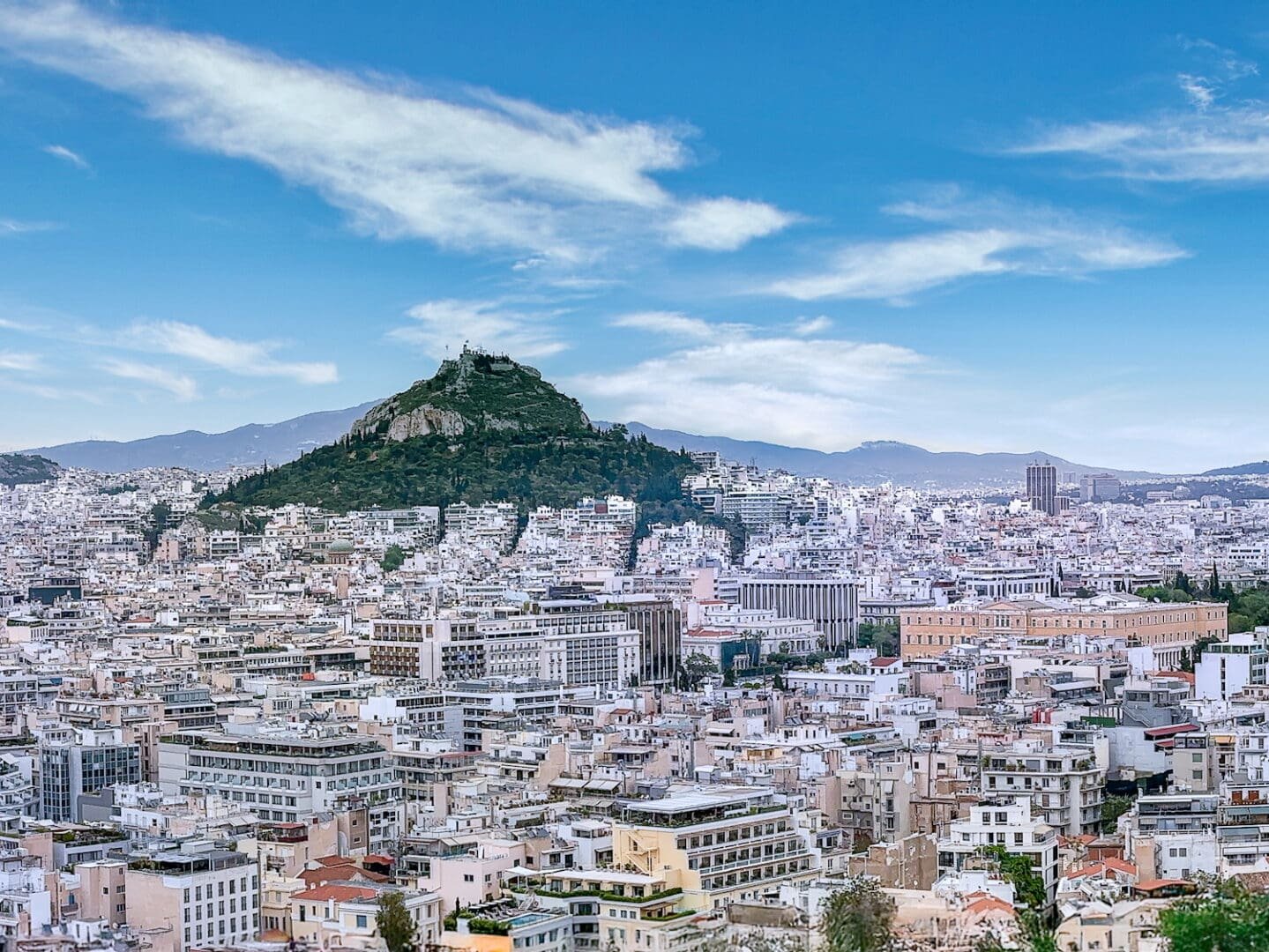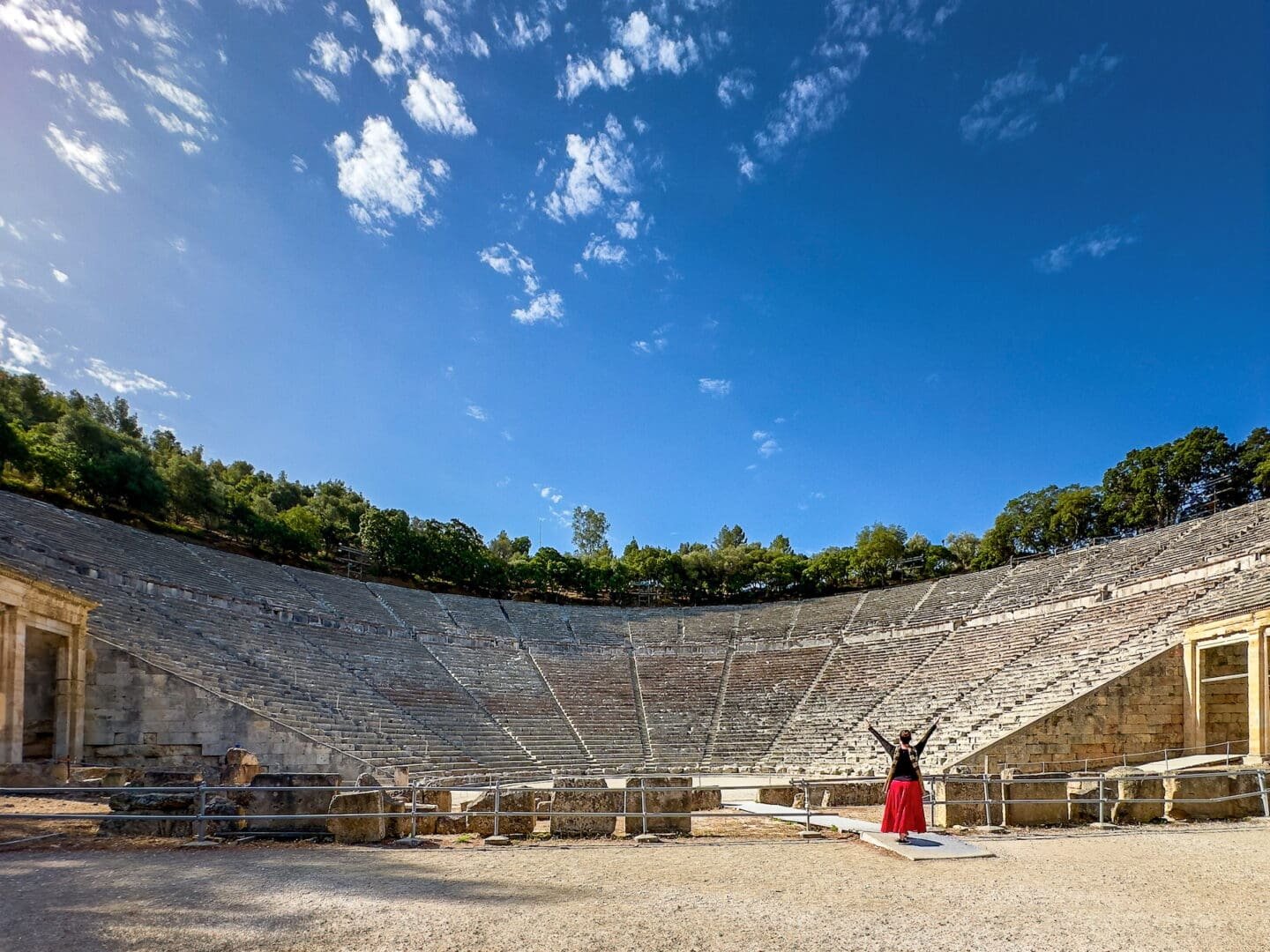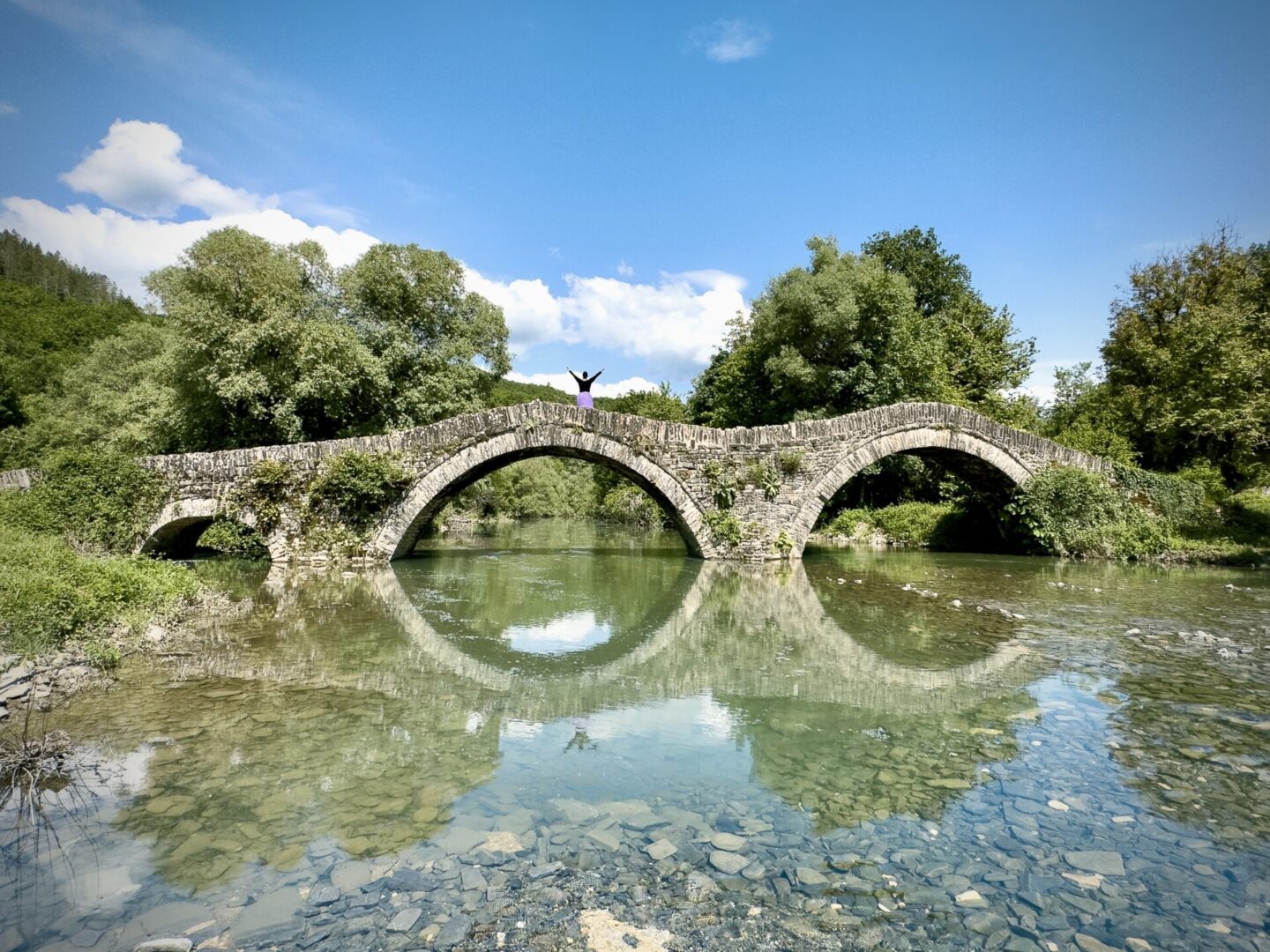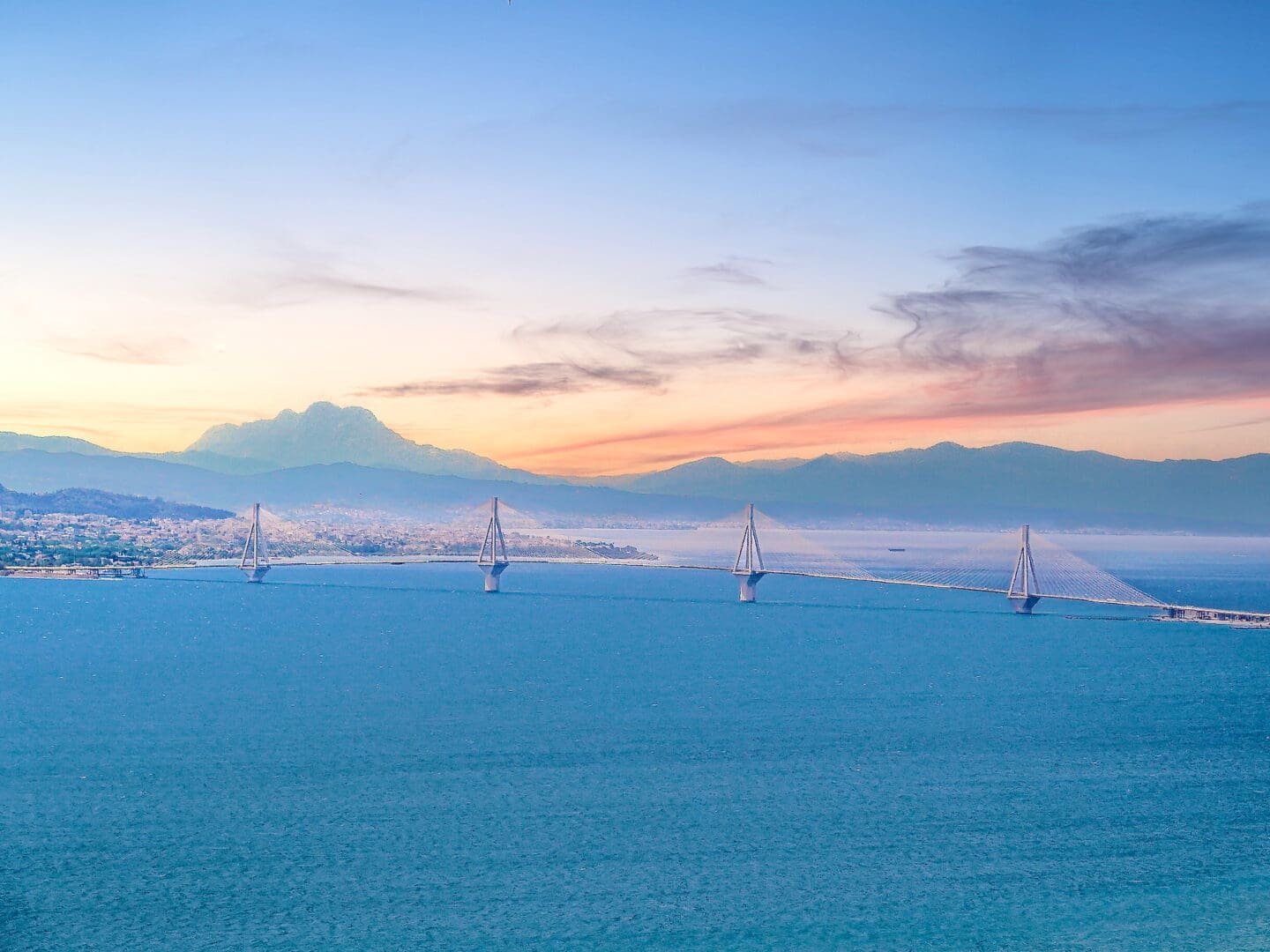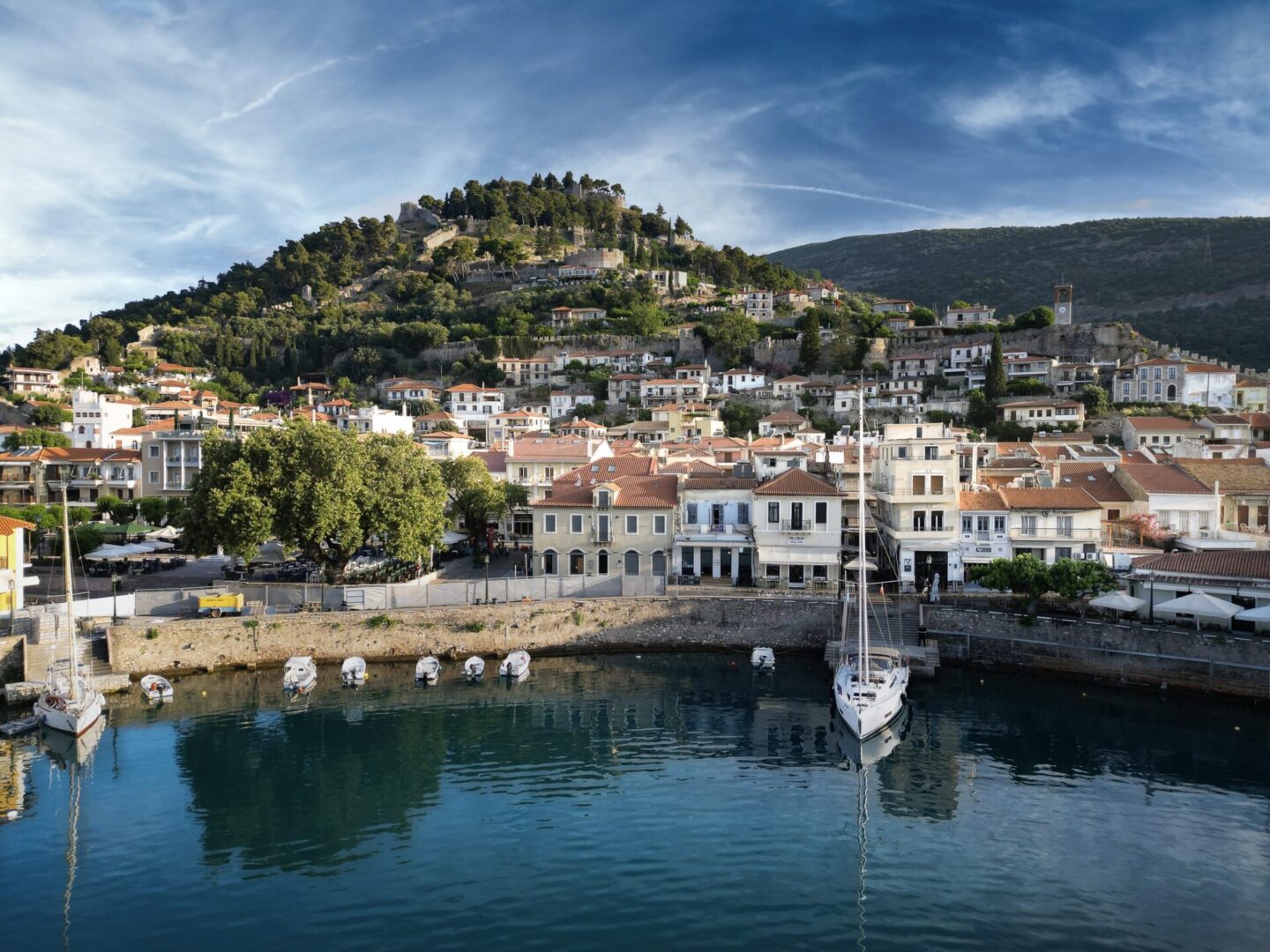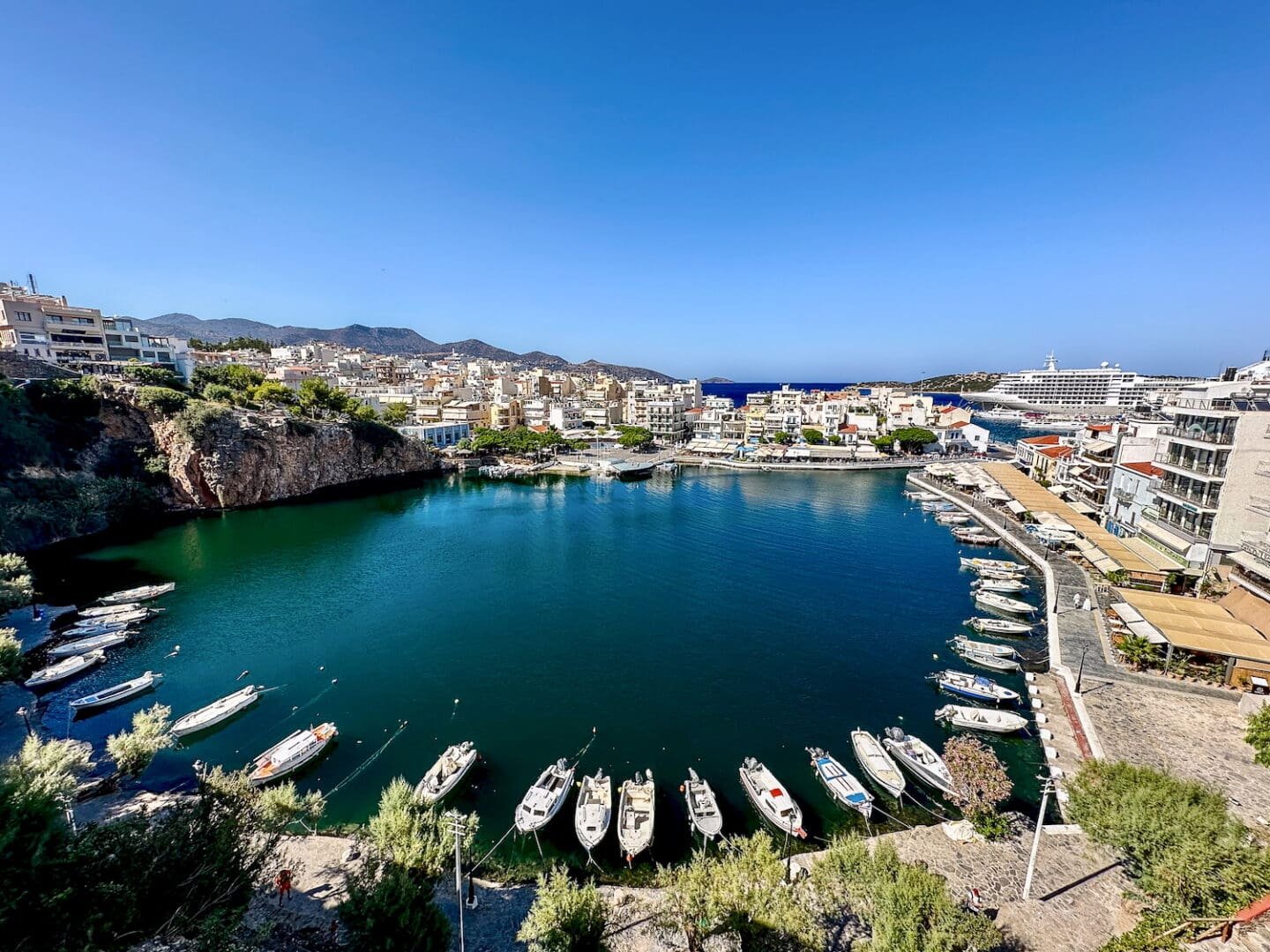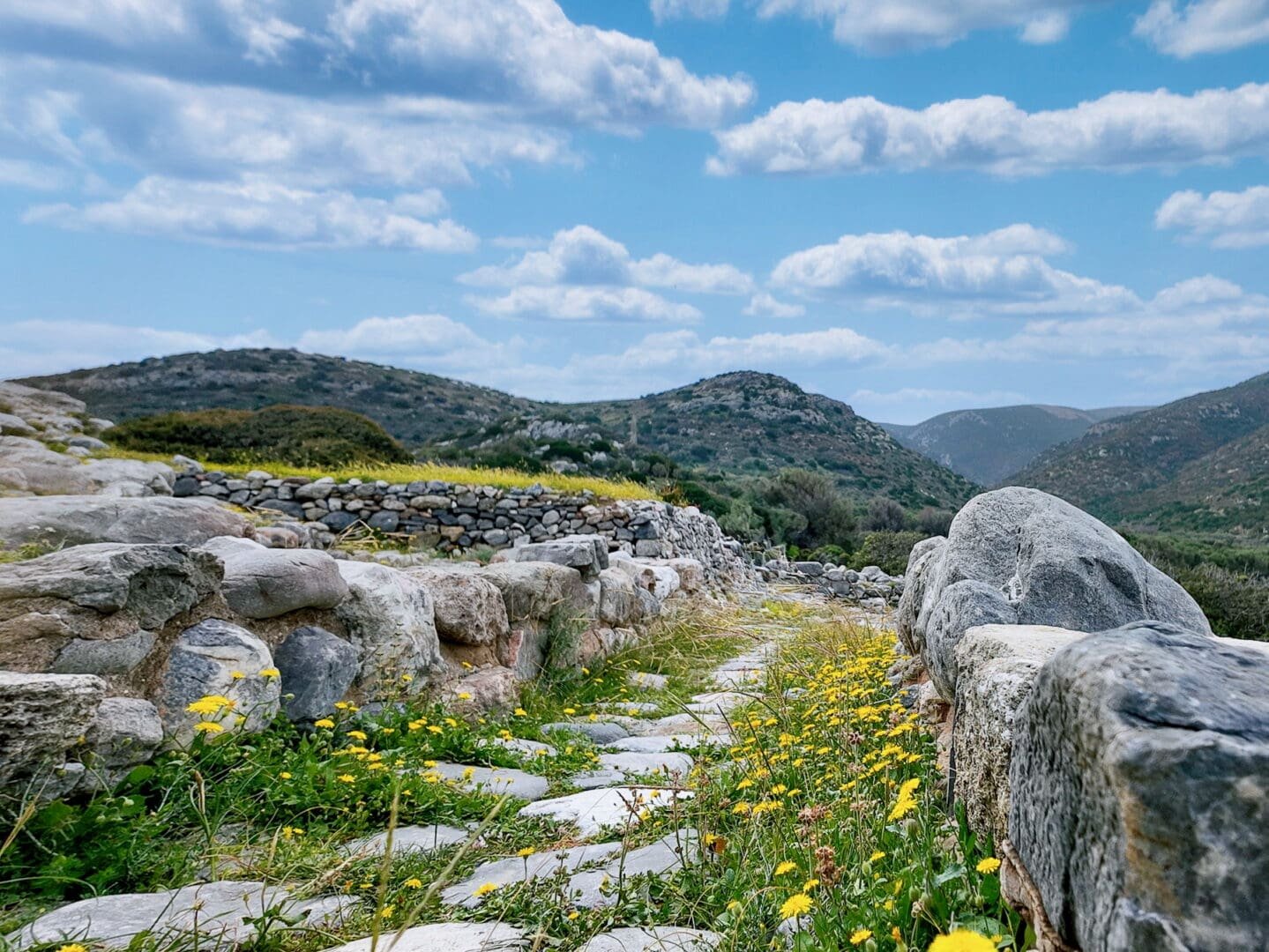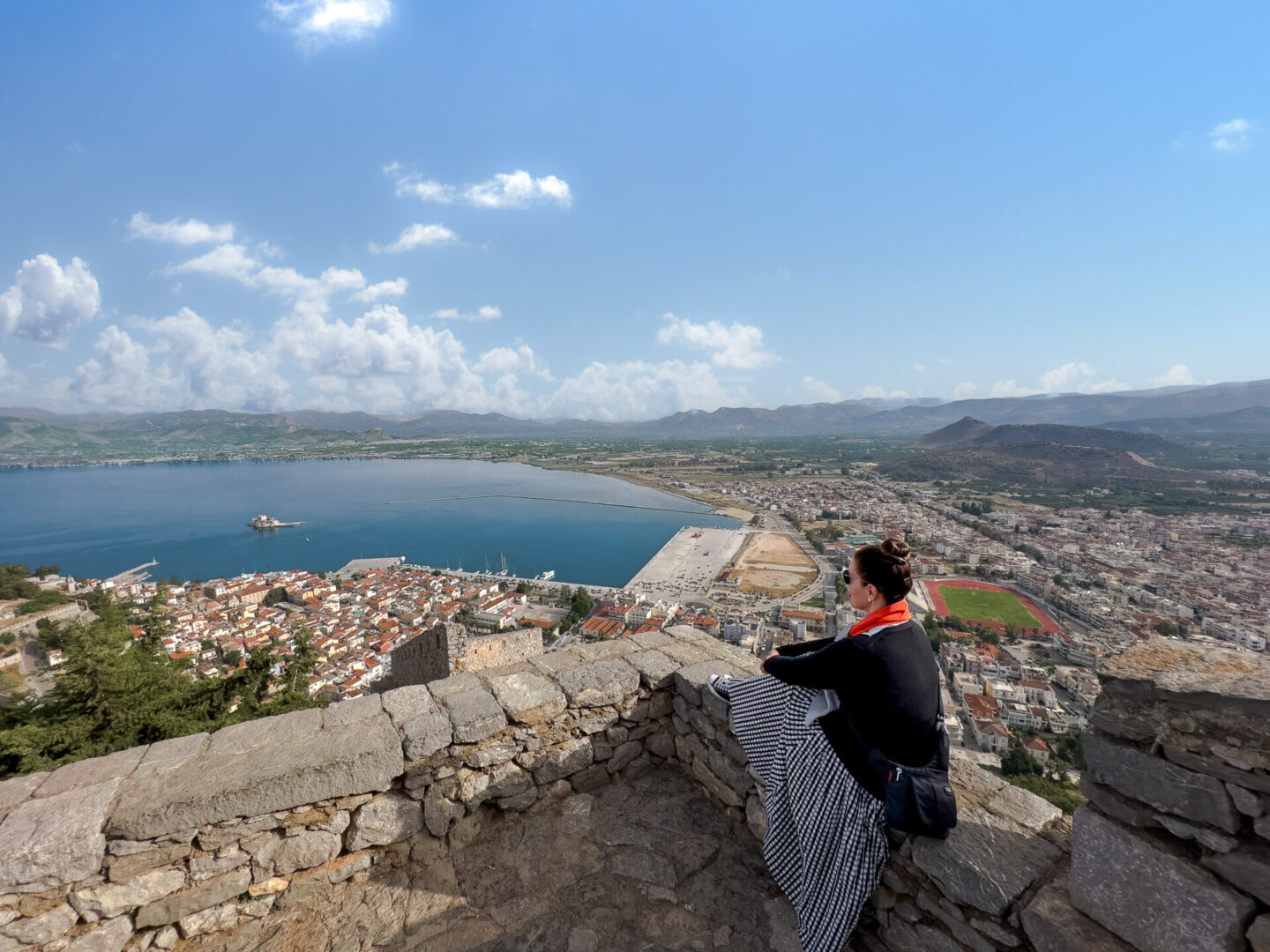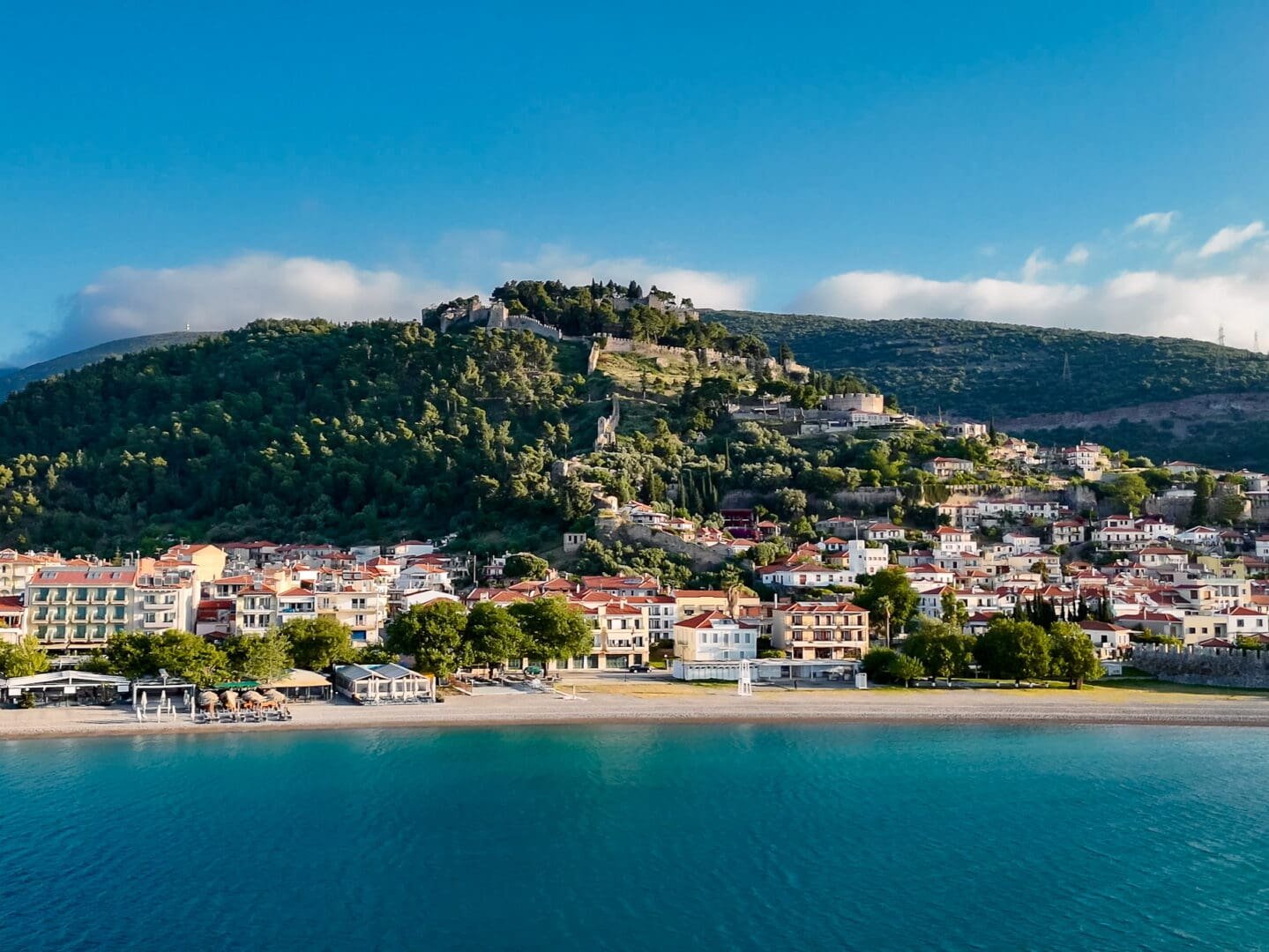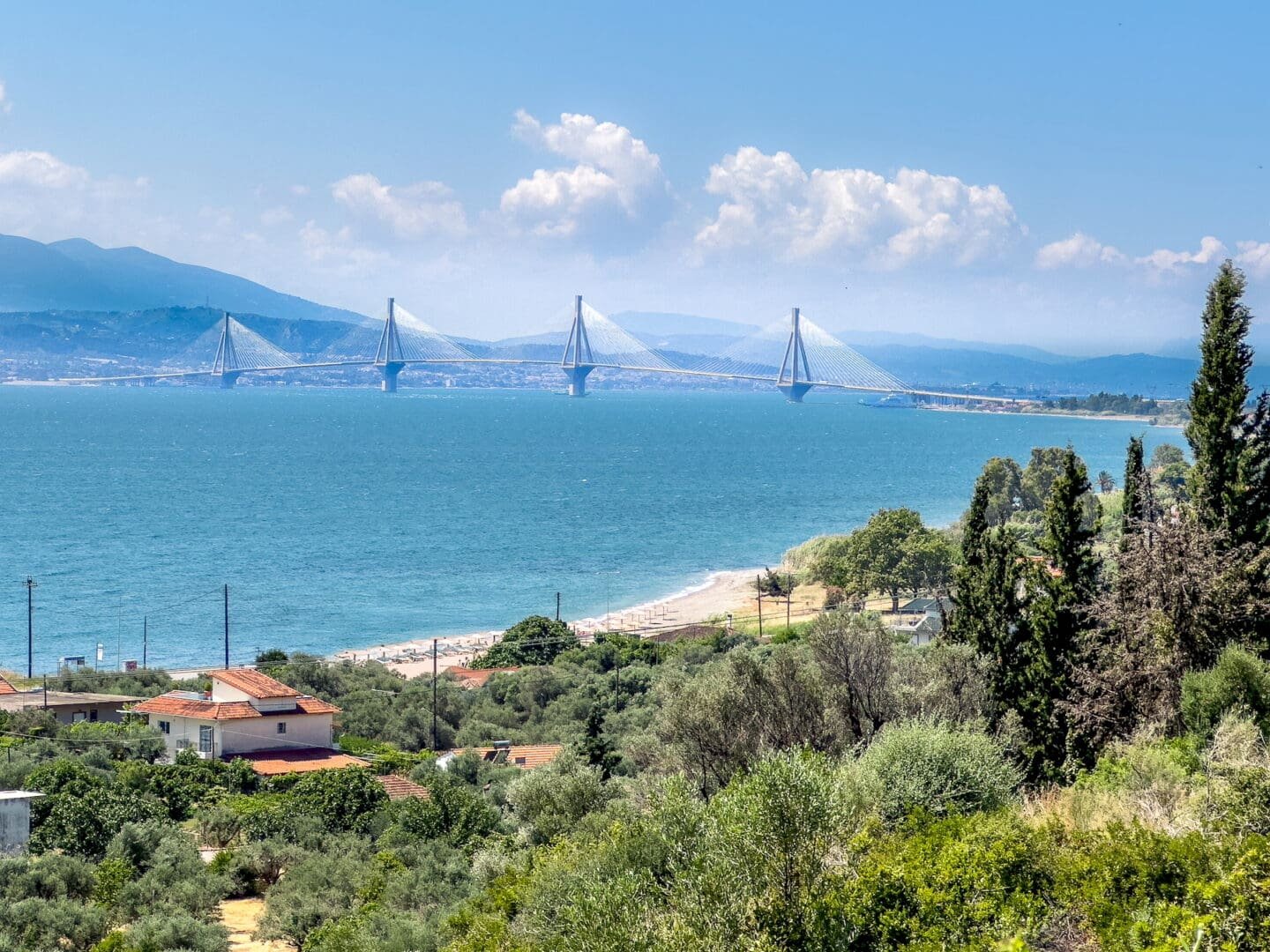
Landmarks in Greece often evoke ancient times shrouded in mists, mysteries, and mythology.
The most famous landmarks do indeed date from ancient Greece, connecting Greek gods, heroic legends, and actual historical people.
However, Greece and its famous landmarks span the ages, from far-distant antiquity to medieval epochs to the present-day modern nation.
Greece offers so much to explore, experience, and inspire your memorable and meaningful journey.
Wherever wanderlust takes you in Greece, there are significant and special landmarks of Greece to delight you.
Throughout the 14 official Regions of Greece, this remarkable country delivers rich history, cultural traditions, and natural beauty alongside ancient ruins.
So, let’s discover together some of the best and most beautiful landmarks to visit both in mainland Greece and the Greek Islands.
We’ll also uncover “little legends” – some lesser-known Greek myths, surprising stories, and fascinating facts.
You’ll find custom interactive maps showing all these Greek regions and landmarks.
Plus, travel tips to visit these famous landmarks in popular destinations, as well as remote locations.
As well as firsthand observations and top recommendations from our many meaningful travels in Greece.
Ready? Πάμε, let’s go!
- Map of Greece and Greek Islands by Region
- Introduction to Famous Landmarks in Greece
- Famous Landmarks in Greece: Athens
- Famous Landmarks in Greece: Attica
- Famous Landmarks in Greece: Central Greece
- Famous Landmarks in Greece: Central Macedonia
- Famous Landmarks in Greece: Crete
- Famous Landmarks in Greece: Eastern Macedonia and Thrace
- Famous Landmarks in Greece: Epirus
- Famous Landmarks in Greece: Ionian Islands
- Famous Landmarks in Greece: North Aegean
- Famous Landmarks in Greece: Peloponnese
- Famous Landmarks in Greece: South Aegean
- Famous Landmarks in Greece: Thessaly
- Famous Landmarks in Greece: Western Greece
- Famous Landmarks in Greece: Western Macedonia
- Famous Landmarks in Greece: Mount Athos
- Famous Landmarks in Greece: In Conclusion
- Interactive Map of Famous Landmarks in Greece
- Landmarks in Greece: Ancient Sources
- Landmarks in Greece: Modern Resources
- Check Out More Recommendations
- Famous Landmarks in Greece: FAQs
When you book or purchase through some links, Spotlight Sojourns may earn a small commission at no extra cost to you. Thanks for using our affiliate links!
Map of Greece and Greek Islands by Region
Introduction to Famous Landmarks in Greece
Greece is a country of dazzling depth, breadth, and beauty. With equally dazzling variety, quantity, and quality, her landmarks are among the best reasons to visit Greece.
Nature formed the earliest Greek landmarks at the dawn of time. Nature and humans continue to shape the landmark landscape and seascape today.
Wherever your Greece itinerary takes you, whether mainland Greece or the Greek Islands, an awe-inspiring array of landmarks await you.
Each of the 14 Regions of Greece offers its own claim to landmark fame. Just click to expand the Table of Contents for the astonishing wealth of wonders by region.
When reading this quite extensive article, you’ll note the 14 regions are organized in the governmental order, rather than in alphabetical order.
To clarify, yes, there are indeed 14 Regions of Greece, including the semi-autonomous 14th Region of Mount Athos.
Most Famous Landmarks in Greece
Of course, some Greek landmarks are unquestionably more famous than others. Likewise, some Greek Regions are significantly more touristed than other regions.
Given that, when reading this quite extensive article, you’ll find the most-visited, most famous Greek landmarks are located in the following Regions of Greece:
- Acropolis of Athens in the 1st Region of Attica
- Sanctuary of Delphi in the 2nd Region of Central Greece
- Knossos Palace on Crete in the 4th Region of Crete
- Sanctuary of Asklepios in the 9th Region of Peloponnese
- Palace of the Grand Master of the Knights of Rhodes in the 10th Region of South Aegean
- Ancient Olympia in the 12th Region of Western Greece
Now, let’s discover together the landmarks in Greece, a country of dazzling depth, breadth, and beauty.
Timed Entry to Famous Landmarks in Greece
From early spring through late fall, the line to enter the Acropolis of Athens has always been long, very long. For everyone, yes, even those who could skip the line at the ticket booth.
In order to provide greater protection to the Acropolis and other iconic monuments and a better experience for tourists, the government announced timed entry and capacity limits, which started in September 2023.
From April 1, 2024, the timed entry and capacity limits became permanent, allowing a maximum of 20,000 visitors daily in timed entries per hour at the Acropolis.
We’ve visited the Acropolis of Athens – not to mention other famous landmarks with infamous lines – both before and after the timed-entry system became official.
The timed entry process is easy with advance arrangements. And the experience overall is more enjoyable at popular monuments and museums.
When you book a guided tour or ticket online, your entry time will be clearly specified.
Once you’ve entered, then explore at your own pace and leave at your leisure.
Famous Landmarks in Greece: Athens
Athens is the capital city of Greece, and the capital of the 1st Region of Greece, Attica (Αττική).
Athens has always been the mythical and historical heart of the ancient Hellenic world. It’s also the vital and vibrant hub of the modern Hellenic Republic.
The Greek capital city is thus a treasure trove of landmarks encompassing a seemingly infinite sweep of epochs, empires, and cultures.
So whether you seek the most celebrated landmarks or hidden gems in Athens, your treasure hunt begins here.
Acropolis of Athens
The Acropolis of Athens, Greece’s crowning glory and the world’s incomparable UNESCO World Heritage Site, reigns in majesty above the sprawling Greek capital city.
In the Greek language, acropolis (ακρόπολις) means “high city.” And this peerless high city of Athens is the most visited and most famous landmark in Greece.
The Acropolis of Athens has served as a defensive citadel, cultural center, religious complex, and profound symbol for thousands of years.
The glorious layout we see today dates primarily from the 5th century BC Golden Age of Athens.
Courtesy of four foremost Athenians of that fabled era: the civic and military leader Pericles, the architects Ictinus and Kallicrates, and the sculptor Phidias.
One Golden Age monument on the Athenian Acropolis achieves ultimate status, an icon instantly recognized around the world: the Parthenon.
Address: Acropolis of Athens (Ακρόπολη Αθηνών) | 10558 Athens Greece
The Parthenon
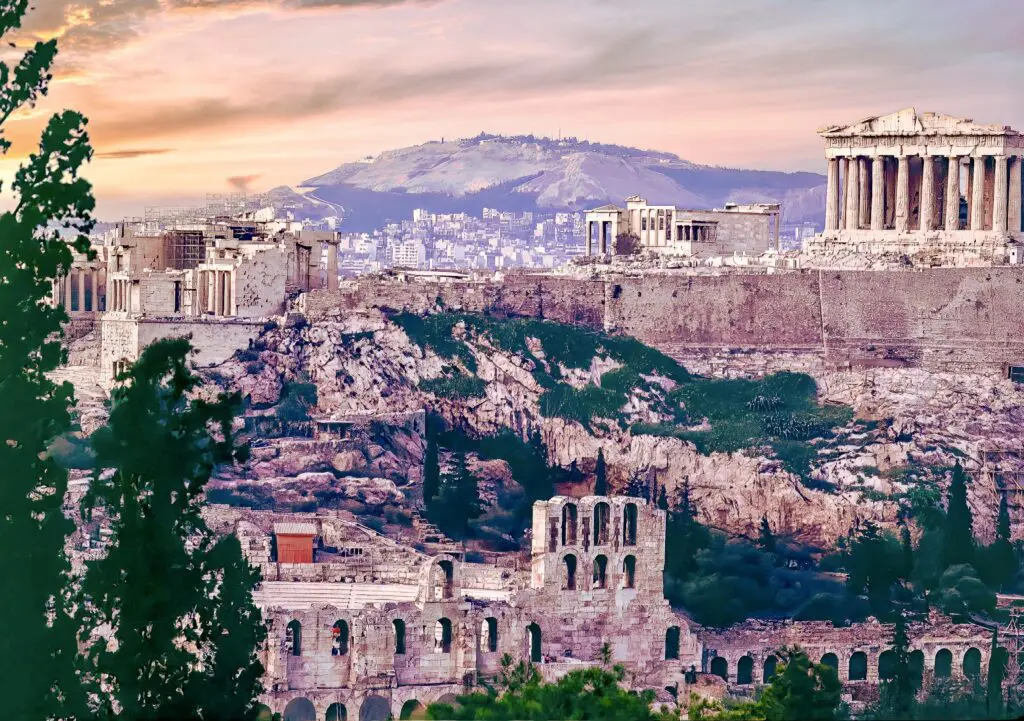
With perfect symmetry and powerful simplicity, the Parthenon expresses high ideals, evokes endless admiration, and inspires enduring awe.
Within the Parthenon, the renowned Phidias sculpted a monumental statue of the goddess Athena in bronze.
Phidias created the mythical likeness of Athena to herald the wealth, strength, and authority of her namesake city, Athens.
Extant coins and literature document and describe the size, design, and symbolism in detail.
When writing his Description of Greece during the 2nd century AD, the geographer Pausanias observes Athena’s bronze helmet and spear gleaming afar on Cape Sounio – over 37 miles (60 km) away!
In the 5th century AD, the great bronze Athena came to Constantinople for its protection and, alas, complete loss.
The Acropolis of Athens Plateau
The Propylaea forms the ceremonial western entryway to the ancient citadel.
To this day, the grand Propylaea remains the primary entrance and exit, up and down roughly 160 steep marble steps.
Other temples, sanctuaries, altars, statues, and scenic viewpoints grace the Acropolis plateau.
Two of the must-see landmarks are the small but striking Temple of Athena Nike and the unique Erechtheion.
Temple of Athena Nike
Located to the right of the Propylaea, the Temple of Athena Nike celebrates Victory.
The architect Kallikrates designed this Ionic temple, and the sculptor Agorakritos created its artwork.
For example, Agorakritos sculpted Nike the Sandalbinder in an unusual pose. With her wings closed, the Nike lifts her foot to slip off her sandal before entering the temple.
The Acropolis Museum displays Nike the Sandalbinder in its priceless collection of Acropolis art and artifacts.
Erechthion, Temple of Athena Polias
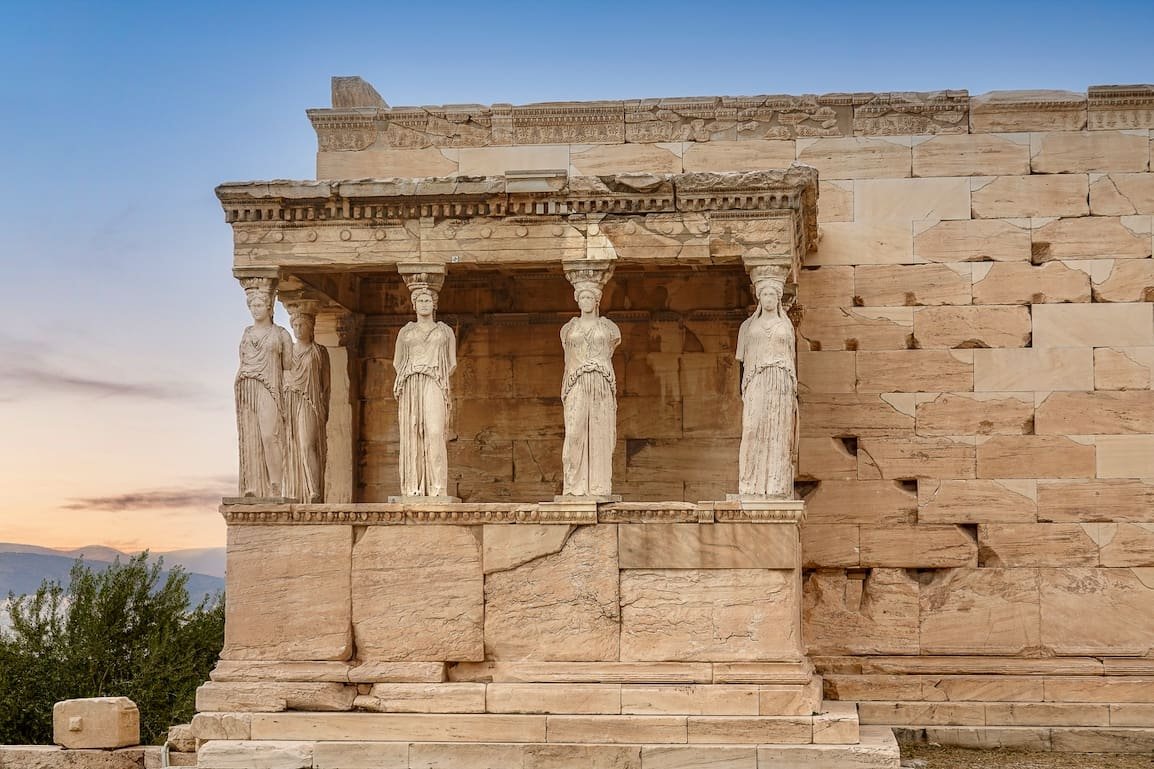
The Erechtheion is the Temple of Athena Polias, Protector of the City, detailed with Ionic columns and intricate ornamentation.
What chiefly sets the Erechtheion apart are two uncommon aspects:
In the first place, the Erechtheion’s asymmetrical design is unlike other classical architecture; for example, the Parthenon’s perfect symmetrical balance.
In the second place, its Southern Porch incorporates female figures instead of columns to support the roof.
Six harmonious marble maidens hold aloft the Southern Porch of the Caryatids.
Today, because of Athens’ pollution, these six sisters are exact reproductions of the original statues.l
Five original Caryatides are in the Acropolis Museum. The sixth original Caryatid is in the British Museum of London, England.
Greek Landmarks Little Legend of the Acropolis of Athens
The Caryatides were actual maidens, not myths or allegories. Their birthplace was Caryes, a village in the mountainous Peloponnese Region.
Or rather, let’s use the present tense: The Caryatids’ birthplace IS Caryes. Because well off the beaten path though it is, the ancient village is still inhabited today.
When traveling across Greece in the 2nd century AD, Pausanias visited Caryes and described the Caryatides’ dance. Opa!
Tips to Visit the Acropolis of Athens
Expert insight enhances everything there is to see and understand about the Acropolis of Athens, the first and foremost of Greece’s most important archaeological sites.
So the best way to elevate your experience on the Acropolis of Athens is with a professional local tour guide.
Discover the best Acropolis tickets and guided tours for your timed-entry visit.
The best time to visit typically is either early morning or late afternoon.
The Acropolis of Athens is open daily year-round, from sunrise to sunset, with the raising and lowering of the Greek flag.
Weather permitting, of course. During extreme heat waves, the Acropolis closes in the hottest hours.
Whenever you visit, the best things to bring are bottled water, a hat, sunglasses, and sunscreen. Because the ancient citadel has no services and little shade.
Wear comfortable and ideally sturdy shoes to climb up and down the Acropolis’ steep steps and on its uneven plateau.
Please note, these same travel tips essentially apply to ancient places and historical locations overall throughout Greece, islands and mainland alike.
Firstly, you’ll ascend a paved pathway to the Acropolis entrance gate and then continue up the slope.
Secondly, as mentioned above, you’ll climb up approximately 160 original marble steps. Later, you’ll descend in the same manner, too.
Although the main route across the plateau is paved, other areas entail cobbled stones and rough ground.
However, a modern elevator does provide Acropolis access specifically for mobility-impaired visitors and parents with two or more infants.
The Greek government’s official agency, Hellenic Heritage, has information on Acropolis elevator access regulations and protocols.
Ancient Agora of Athens
Dating from the 6th century BC, the Ancient Agora of Athens was an essential hub of classical urban life.
From libraries to law courts, artists to assemblies, socializing to shopping, the Ancient Agora of Athens encompasses a broad spectrum of stoas, temples, monuments, and even a mint for coinage.
During the 1st century AD, the Apostle Paul preached daily here in the Agora, as well as the synagogue and Areopagus Hill.
Atop the rocky outcrop of Areopagus Hill, about 3 miles (5.1 km) away, a bronze plaque memorializes Paul’s powerful sermon in Acts 17:16-34.
The Ancient Agora is a great place to visit, explore, and consider Athens’ everlasting interplay of past and present – particularly when the Athens Metro rumbles by.
The colonnaded Stoa offers an especially elegant escape from the summer heat or winter rain. A short walk under its fully restored roof is a refreshing respite.
You’ll further find ancient sculptures, archaeological artifacts, and the museum gift shop within the Stoa.
Fifth century BC Temple of Hephaestus stands among the Ancient Agora’s most impressive landmarks. Marble steps guide you up to its commanding hilltop position.
Well preserved and almost wholly intact, the Hephaisteion helps you envision the Parthenon in its original state.
Address: Ancient Agora of Athens (Αρχαία Αγορά Αθηνών) | 10555 Athens Greece
Syntagma Square and Tomb of the Unknown Soldier

Athens’ heart and city center is Syntagma Square, an enormous plateia in front of the Old Royal Palace, housing the Greek Parliament since 1934.
Amalia Avenue, Otto Street, and King George I Street flank the square and lead to popular tourist attractions in nearby neighborhoods such as Plaka, Monastiraki, and Psiri.
Ermou Street, Athens’s top shopping street, links Syntagma and Omonia Squares.
Constitution Square is a busy transportation hub with Metro and Tram stations, bus stops, taxis, non-stop traffic, and pedestrians galore.
Broad marble steps lead to the Old Royal Palace, a neoclassical historical landmark completed in 1843 after King Otto of Greece moved the capital to Athens from Nafplio.
The Old Royal Palace, formerly the residence of King Otto and Queen Amalia, is now the Parliament Building and Presidential Mansion.
The grounds also contain the Tomb of the Unknown Soldier, a cenotaph dedicated in 1932, and the Eternal Flame.
Evzones (Εύζωνες), the Hellenic President Guard, guard the national monument around the clock.
On the hour, the Evzones perform a Changing of the Guard, a slow and serious ceremony unique among nations.
Address: Syntagma Square and the Monument of the Unknown Soldier (Πλατεία Συντάγματος και Μνημείο του Αγνώστου Στρατιώτη) | Leoforos Vasilisis Amalias 133 | 10557 Athens Greece
Greek Landmarks Little Legend of the Evzones

The historic guard selects its elite members from the finest standouts of the Hellenic Army.
Evzones are famed for their distinctive height, steadfast discipline, and elaborate uniform.
History, tradition, and symbolism infuse every aspect of the corps’ uniforms. All uniforms are made entirely by hand for the guards.
For example, the foustanella (φουστανέλλα) is a white pleated skirt worn for centuries. Tsourachi (τσαρούχι) is a red leather shoe featuring black silk poms on the toe and hobnails on the sole.
The Evzones wear particularly weighty foustanella with 400 pleats representing 400 years under Ottoman rule.
Likewise, national history and military heritage suffuse each step of the ceremony.
At the top of the hour, Evzones move through their measured paces in the Changing of the Guard.
During this respectful ritual, their rhythmic strikes make the only sound. Then, each Evzone resumes his motionless stance.
Some tourists may chuckle, surely due to a lack of understanding.
However, each element of the uniform and every motion of the ceremony are purposeful, meaningful, and meticulous.
Tips to View the Changing of the Guard
Firstly, every day and night at the Tomb of the Unknown Soldier, the Evzones perform the Changing of the Guard.
Precisely on the hour, all 24 hours. In all seasons and all weather – pouring rain, freezing cold, or searing heat.
Secondly, every Sunday at 11:00 am, the corps and military marching band parade down Leoforos Vasilisis Sofias in the Grand Changing of the Guards.
You may freely come and go to watch the Changing of the Guard and the Grand Changing of the GuardsGuard.
Thirdly, every day at the Athenian Acropolis, the Evzones raise and lower the flag at sunrise and sunset.
So depending on your timed-entry ticket, you may also get to see the flag ceremony.
Temple of Olympian Zeus

Not to be confused with Olympian Land in Western Greece, the Temple of Olympian Zeus dominates a vast archaeological site in Athens.
This largest temple in the ancient world took centuries to complete. Construction began more than 500 years before Christ.
Under Roman Emperor Hadrian, construction eventually finished in the 2nd century AD.
The triumphal Arch of Hadrian is a short walk from the Temple of Olympian Zeus.
On one side, Hadrian’s Gate proclaimed, “This is Athens, the ancient city of Theseus.”
Then on the opposite side, Hadrian’s Gate asserted, “This is the city of Hadrian and not of Theseus.”
Address: Temple of Olympian Zeus (Ναός του Ολυμπίου Διός) | 10557 Athens Greece
Address: Arch of Hadrian (Πύλη Αδριανού) | Leoforos Vasilisis Amalias 50 | 10558 Athens Greece
Tips to Visit the Temple of Olympian Zeus
Sections at the Temple of Olympian Zeus are presently under scaffolding for necessary restoration work.
The Arch of Hadrian, however, with its Corinthian columns, is fully visible in all its Roman glory.
Panathenaic Stadium
The Modern Olympics originate in Greece: Firstly, at the famous landmark of Ancient Olympia in the Western Region. Secondly, at the Panathenaic Stadium in Athens.
The site of a racecourse since the 6th century BC, the Panathenaic Stadium originally hosted the Panathenaic Games every four years from the 4th century BC until the 3rd century AD.
Abandoned for centuries, the ruined stadium was restored and refurbished in the 19th century.
In 1896, the world’s only stadium made of marble hosted the first international Modern Olympic Games, the Games of the 1st Olympiad; as well as the 2004 Summer Olympics, the Games of the 28th Olympiad.
Additionally, before every Olympics, the Panathenaic Stadium hosts the formal ceremony wherein Greece hands over the Olympic flame, lit in Ancient Olympia, to the host city.
Lastly, the Panathenaic Stadium forms the finish line for the annual Athens Classic Marathon.
The race route retraces the legendary run of Phiedippides in 490 BC, bearing the message of victory from the Battle of Marathon to Athens, 26.2 miles (42 km) away.
Address: Panathenaic Stadium (Παναθηναϊκό Στάδιο) | Leoforos Vasileos Konstantinou | 11635 Athens Greece
Tips to Visit the Panathenaic Stadium
The Panathenaic Stadium opens to visitors year-round, events and weather permitting.
The best time to visit during the summer months is early morning and late afternoon.
The Stadium is entirely open to the elements. The exceptions athe Vaulted Passage, i.e., the athletes tunnel, and the adjacent permanent exhibition, “Memories from Olympic Games.”
Make sure to bring water, a hat, sunglasses, and sunscreen in the summer months. In cooler months, wear layered warm clothing.
And oh yes, do bring sneakers! Because the entrance fee includes access to stroll, speed walk, or run the track.
After taking your triumphant lap around the track, commemorate the moment with your photo atop the medal podium. In the first-place position, of course.
For another fabulous photo spot, climb to the upper tier of the Stadium, notably Stand 21.
This lofty perspective reveals lovely sights such as Filopappou Hill, the Temple of Olympian Zeus, Zappeion Megaron in the National Gardens, and Mount Lycabettus.
From the top of Stand 21, seeing that spectacular view of the Acropolis of Athens is a gold-medal moment in itself!
Mount Lycabettus

The highest point in Athens is Mount Lycabettus, rising 908 feet (277 m) in the city center.
From the top, sweeping views encompass the entire capital city. From ancient history to today’s modern metropolis, the Athenian sights dazzle and delight.
Besides the panorama, there is a cafe-restaurant and two churches: 19th century Agios Georgios on the plateau; and Agios Isidoros, circa 15th to 16th century, on the western slope.
The 1960s Lycabettus ampitheatre awaits restoration and is thus closed at this time of publication.
To ascend or descend Mount Lycabettus, either drive or take a taxi up the Lycabettus ring road. Or climb a long, steep hike up zig-zagging stairs.
But the fun thing to do is ride the Lycabettus Funicular. The funicular offers a three-minute tunnel ride up and down the hill – inside the hill, that is! – between Konolonaki Station and Agios Georgios.
Address: Lycabettus Hill and Funicular (Τελεφερίκ Λυκαβηττού) | Aristippou 1 | 10676 Athens Greece
Famous Landmarks in Greece: Attica
The 1st Region of Greece, Attica (Αττική) expands well beyond Athens, the Greek capital and regional capital city.
As in antiquity, when the Sacred Way led from ancient Athens to Eleusis, now contemporary superhighways similarly lead to modern Athens’ suburbs and the Aegean Sea.
Cosmopolitan communities of the Athens Riviera line the southern Attica coast. Then, the Saronic Islands are but a brief ferry ride across the Saronic Gulf.
Temple of Poseidon
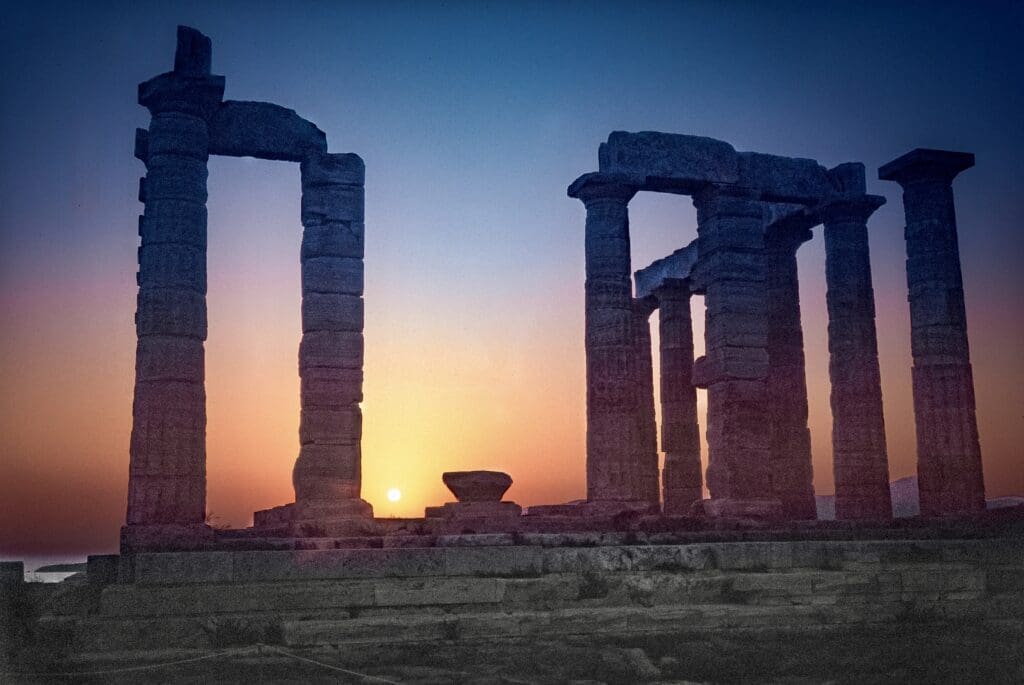
The magnificent Temple of Poseidon commands the Cape of Sounio on Attica’s Aegean Sea. Protected since 1974, Sounio is the smallest of Greek National Parks.
The Saronic Gulf Islands set the stage for this spectacular site of two Greek gods.
Dedicated to the mythological sea god, the ancient Temple of Poseidon dates from the 5th century BC. Of the original 34 Doric columns, 13 still stand in stark splendor.
Nearby on a lower level, the Temple of Athena Souniados leaves behind only a few ancient stones.
Constructed in the same timeframe as the Temple of Poseidon, the 5th century BC, Athena’s temple was obviously less important. Because her entire temple was later disassembled in order to build other structures in Athens.
Not only is the sanctuary a historical landmark, but it also serves as a nautical landmark.
From the sea, ancient sailors saw these mighty marble pillars and knew they were nearing Athens. In the same way, ferry and cruise ship passengers thrill at the sublime sight.
From the shore, the Temple of Poseidon is a perfect place to watch the breathtaking sunsets.
Address: Temple of Poseidon (Ναός Ποσειδώνα) | 19500 Sounion Greece
Tips to Visit the Temple of Poseidon
For a standard starting point, the driving distance between Athens International Airport “Eleftherios Venizelos” (ATH) and Cape Sounio is about 28 miles (45 km).
The route takes roughly 1.5 to 2 hours, depending on traffic and weather conditions.
If you choose to drive, be aware; because the final stretch of road can be challenging, especially after dark.
Public KTEL buses, the OASA subway, and long-distance taxis are further options.
Or, for comfort, convenience, and expert insight, we highly recommend a guided sunset tour with round-trip transportation between Athens and Cape Sounion.
Famous Landmarks in Greece: Central Greece
The 2nd Region of Greece, the Central Region, is also fondly known as Solid Greece (Στερεά Ελλάδα).
The regional capital Lamia and rural Greek Island Euboea (Evia) typify the traditional charms and slower pace of Central Greece.
Sanctuary of Delphi

Mount Parnassus in Central Greece holds an archaeological site of immense importance and wealth: the Sanctuary of Delphi.
For millennia, visitors traveled from afar to consult Pythia, the mysterious Oracle of Delphi by whom Apollo spoke.
Today, visitors travel from afar to explore this UNESCO World Heritage Site, among Greece’s most important landmarks.
The god Apollo ruled supreme at the Sanctuary of Delphi. And the Temple of Apollo was his seat of supremacy.
Inside the Temple of Apollo, the high priestess Pythia sat on a tripod seat and proclaimed Apollo’s mystical Delphic Oracles.
The massive Apollon dates from the 4th century BC built over ancient ruins of earlier temples.
The site encompasses plentiful altars, stoas, treasuries, stoas, and temples. A gymnasium, hippodrome, stadium, and theatre attest to the festivals held throughout the ancient calendar.
Down the slope from the main site, the circular Tholos of Athena Pronoia has three Ionic columns set along its circular edge,
It’s debatable whether the temple to the god Apollo or to the goddess Athena of Providence is the most photographed monument in Delphi.
Address: Temple of Apollo (Ναός του Απόλλωνα) | 33054 Delphi Greece
Greek Landmarks Little Legend of Delphi
The ancient Greeks believed the Sanctuary of Delphi to be the center of the earth. Literally.
Legend tells us that Zeus sent two eagles in flight from opposite ends of the earth; their paths crossed here, between the Phaidriades peaks.
Inside the Temple of Apollo, the Omphalos monument marked the eagles’ intersection and the earth’s “navel.”
Tips to Visit Delphi
The driving distance between Athens International Airport “Eleftherios Venizelos” (ATH) and Delphi is approximately 124 miles (200 km).
KTEL public transportation buses and long-distance taxis are options without a car.
Transportation aside, the best way to experience this far-reaching and far-flung archeological site is with a professional local guide.
Check the best Delphi tour options.
Famous Landmarks in Greece: Central Macedonia
The second-largest city in Greece, Thessaloniki is the regional capital of the 3rd Region of Greece, Central Macedonia (Κεντρική Μακεδονία).
Also known as Saloniki, Thessalonica, and Salonica, Thessaloniki is a dynamic hub for the arts, fashion, finance, technology, and gastronomy innovations.
Furthermore, Thessaloniki is a top tourist destination. CNN names Thessaloniki among the world’s Best Destinations.
White Tower of Thessaloniki

Few sites impart the city’s influential status better than its once fearsome and infamous landmark: Lefkos Pyrgos, the White Tower of Thessaloniki.
Formerly a defensive fortress and a notorious prison, the centuries-old tower remains an imposing fixture on the waterfront.
Its severe stone exterior is unmistakable, at 112 feet (34 m) in height, topped by a turret another 20 feet (6 m) high.
Tradition maintains that the Venetians built this current tower circa 15th or 16th century. Meanwhile, scholars ascribe its construction to the Ottomans and debate its exact date of construction.
Address: White Tower of Thessaloniki (Λευκός Πύργος Θεσσαλονίκης) | White Tower Square | 54621 Thessaloniki Greece
Greek Landmarks Little Legend of the White Tower
The White Tower of Thessaloniki has different names: Lion Tower, Tower of Janissaries, Tower of Blood, Red Tower, and the Bastille of Thessaloniki.
The origin of the White Tower name comes straight from the Museum of Byzantine Culture:
In 1883, Sultan Abdul Hamid II ordered the tower to be painted white to indicate that “winds of reform were blowing in the Ottoman Empire”.
In short, a convicted prisoner named Nathan Guiledi volunteered to paint the tower white. Offer accepted and the work completed, Guiledi thus gained his freedom.
Tips to Visit the White Tower of Thessaloniki
Before the 20th century, fortifications fully encircled the White Tower of Thessaloniki. In 1911, the defensive walls came down.
Now, that means you can walk right up to the Tower, wander its circumference, and, of course, take photographs at any time.
With its splendid setting on the Thessaloniki waterfront, the White Tower is a popular spot for locals and tourists alike to watch the sunset.
Mount Olympus

The mythical home of Greek gods, Mount Olympus is Greece’s highest mountain and tallest natural landmark.
Piercing the sky above the Regions of Central Macedonia and Thessaly, the highest point is Mytikas Peak at 9,572 feet (2,917 m) above sea level.
In 1938, Greece created its first National Park across 92 square miles (238 km2) on this most legendary mountain.
In 1981, Mount Olympus National Park became a UNESCO World Biosphere Reserve.
The reserve protects forests, gorges, ravines, rivers, waterfalls, and over 1,700 species of flora and fauna. Several species are rare and endangered, such as the bearded vulture and golden eagle.
Hiking and climbing Mount Olympus is the main attraction here. Trails range from gentle mountain paths to serious summit ascents.
Address: Mount Olympus (Όλυμπος) | 40200 Olympos Greece
Greek Landmarks Little Legend of Mount Olympus
Greek mythology and Homeric traditions describe Olympus as the ethereal realm of the Panhellenic gods.
Twelve Olympian gods resided in these celestial heights, inhabiting palaces and meeting together at the Pantheon of Mount Mytikas.
Muses and other immortals lived in its foothills.
In due time, real-life Iron Age mortals followed and built their villages here.
Tips to Visit Mount Olympus
Located on Olympus’ northern slope under Mytikas’ peak, Litochoro is the main town for visitors, walkers, mountain bikers, canyoners, climbers, and mountaineers.
Litochoro is the home base for the main hiking associations. Because the most popular climbing route starts here to the Enipeas Gorge.
Additionally, Litochoro hosts the official Mount Olympus National Park Information Center, an invaluable information resource.
If you desire a delightful day in nature, then a slow-paced guided excursion is a great choice here.
When you want serious hiking or high-adrenaline outdoor adventures, then a certified mountaineering guide is necessary.
Explore the guided tours and adventure excursions.
Inside Mount Olympus National Park, a variety of mountain refuges accommodate overnight stays.
Most are organized refuges; several refuges have restaurants. Six refuges are strictly for emergency shelters.
A few refuges remain open year-round; others open seasonally from May or June through October.
The Olympus National Park Refuges Page has all the details, reservations, and contact information.
Famous Landmarks in Greece: Crete
The 4th Region of Greece is Crete (Κρήτη), the largest island among thousands of Greek Islands. Large enough that the island of Crete warrants its own region, with Heraklion as the regional capital.
Crete is a year-round island with a thriving large population, well-regarded schools and universities, and diverse economic strength beyond travel and tourism.
Mountain ranges, rivers, lakes, and shorelines define the Cretan terrain. Numerous small islands and islets also throng the Cretan coast.
Crete abounds not only with great natural beauty, but also agricultural bounty in farms, orchards, and especially groves of olive trees.
Since Crete is Europe’s southernmost point – specifically, the small island of Gavdos, Crete – the weather is quite temperate, albeit rainy in winter.
So, Crete attracts visitors all year long through its bustling ports and Heraklion International Airport “Nikos Kazantzakis” (HER).
Furthermore, Crete’s long land mass demarcates the South Aegean Sea from the Libyan Sea.
Samaria Gorge

Crete’s six mountain ranges and nine gorges protect forests, flora, and fauna, including the vulnerable kri-kri Cretan goat.
The world-famous Gorge of Samaria National Park carves a thrilling natural path between the White Mountains and Mount Volakias, on the southwest coast near Chania.
Part of the EU Natura 2000 Network, Samaria Gorge is a UNESCO World Biosphere Reserve.
The Gates are the most dramatic and distinctive part of the rugged trek. Here, the width narrows to about 13 feet (3 m) wide, and steep walls reach 980 feet (298 m) high.
This is Europe’s longest gorge, extending about 8 miles (13 km) from north to south.
With another 2 miles (3 km) to the village of Agioumeli to return via ferry boat, the total distance of Samaria Gorge from start to finish is 10 miles (16 km).
Address: Samaria Gorge (Φαράγγι Σαμαριάς) | 73011 Sfakia Crete Greece
Tips to Visit Samaria Gorge
In season from May 1 to October 31, Samaria Gorge National Park opens daily from either 6 am or 7 am until 4 pm, weather permitting.
Overall, Samaria Gorge is a challenging trek. The trail is a long, steep descent; with rocky outcrops and several river crossings either by small wooden bridges or stepping stones.
It’s a full-day hike, so the best time to start is early morning. Then, to return from Agia Roumelia to Chania requires a boat passage.
The Gorge has two access points: north at Xyloskalo near Omalos Plateau and south near the village of Agia Roumeli.
Xyloskalo is the highest point at 4,025 feet (1,227 m) and the logical entrance. Because the trail descends from Xyloskalo to the lowest point Agia Roumeli, on the sea.
The best things to bring are water, layered clothing, a hat, sunglasses, sunscreen; and proper hiking shoes or hiking boots.
Also, plan ahead to put food and any essentials in your daypack. Because there are no shops or services inside Samaria National Park.
Natural springs flow within the Gorge to re-fill bottles or canteens with fresh water.
For public transportation, KTEL buses run to Omalos.
Agia Roumeli has no access except by sea. Anendyk Seaways operates the Aiga Roumelia ferry service.
For ease and convenience of round-trip ground transportation and ferry ticket, as well as the benefit of a professional local trekker, consider a guided hike.
See the best options for hikes and outdoor adventures.
Minoan Palace of Knossos

Just beyond Heraklion, you’ll find Crete’s most famous historical landmark and one of its top tourist attractions: Knossos.
The Palace of Knossos and other important archaeological sites display the arts and sciences of a highly advanced prehistoric culture: the Minoans.
Altogether, Knossos and five other Minoan palatial centers form the newest UNESCO World Heritage Sites in Greece. UNESCO inscribed the six Minoan Palatial Centres in July 2025.
The Bronze Age Minoan civilization dates from the 28th century BC to the 15th century BC. Basically, the Minoans pre-date the Myceneans.
In 1878, local Greek amateur archaeologist Minos Kalokairinos discovered the palace site.
Later, from 1900 to 1931, British archaeologist Sir Arthur Evans directed excavations of the Knossos labyrinth, ancient city, cemeteries, and more.
Sir Arthur Evans’ excavations, research, and reconstructions made a lasting impact on our understanding and interpretation of the archaeological site and the Minoan civilization.
Evans determined the singular aspects of the ancient site, art, and artifacts. Additionally, he deciphered Minoan Scripts Linear A and Linear B.
Moreover, Evans reconstructed and repainted certain areas; for instance, the Northern Entrance, Throne Room, and Royal Villa.
As a result, the Minoan Palace of Knossos may not reflect the carefully chosen materials and scholarly restorations of modern archaeologists and conservators.
But it’s surely a most vivid and colorful reconstructed landmark of Ancient Greece.
Address: Knossos Palace (Ανάκτορο Kνωσού) | 71409 Knossos, Crete Greece
Greek Landmarks Little Legend of Knossos Palace

In his epic myth Metamorphoses, the poet Ovid narrates the cautionary tale of Daedalus and his son Icarus.
Architect and inventor Daedalus designed the labyrinth at Knossos. But he yearned to elude King Minos, escape the ancient city, and return home to his native land.
So, clever Daedalus crafted great wings of feathers held together by beeswax. Accordingly, the pair escaped.
Although his father had instructed Icarus to fly neither too high nor too low, the lad couldn’t withhold his exuberance. Higher and higher, he flew.
Until, alas, young Icarus flew too close to the sun. The scorching heat melted the wax.
With wings disintegrated, Icarus plunged to his death in the dark sea below.
Tips to Visit Knossos Palace
Like Crete itself, Knossos similarly attracts visitors during all 12 months of the year.
For this reason, generally, from spring to fall, it’s generally a good idea to visit Knossos either early morning or late afternoon.
If the latter, then we suggest your timed entry for two hours before closing. This timeframe allows sufficient time to explore the palace and surrounding areas.
The best things to bring to Knossos are bottled water, a hat, sunglasses, and sunscreen.
Also, do wear sturdy shoes. Like many ancient sites, some sections are covered, some paths are paved, and some areas are rough.
On the whole, a guided tour deepens appreciation of the advanced civilization and refined culture in effect on Crete and elsewhere.
We also recommend bundling your visit to Knossos Palace and the Heraklion Archaeological Museum. Combined together, the archaeological site and museum collections of Minoan art, artifacts, and jewelry make ancient history a living experience.
Spinalonga Island
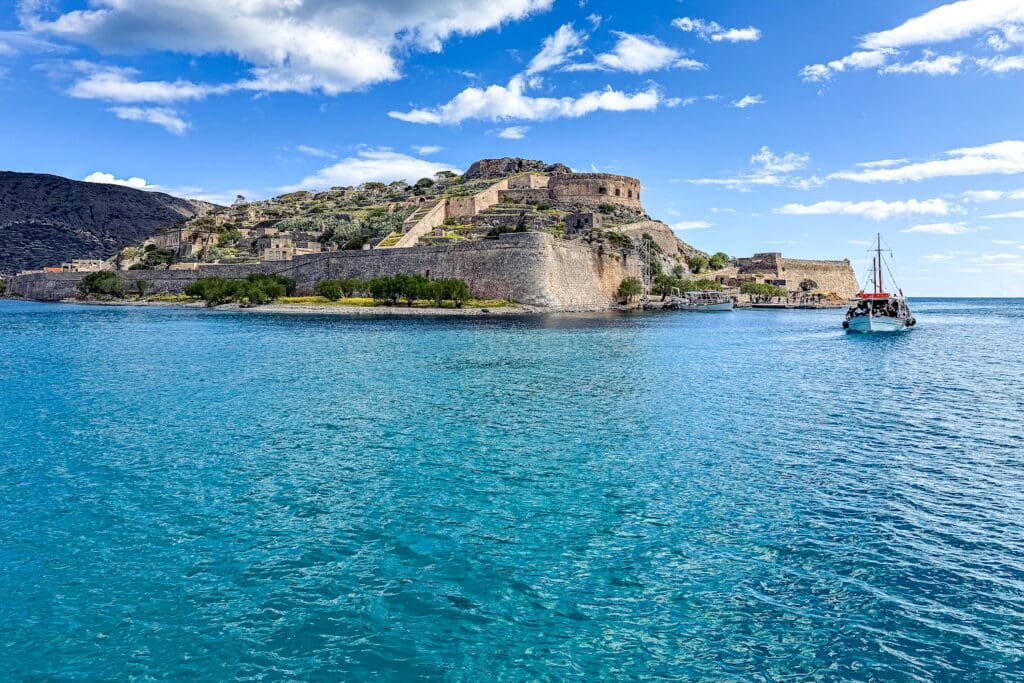
Nearby Elounda’s chic resorts on Crete’s eastern coast, Spinalonga is on the UNESCO World Heritage Tentative List.
From the late 1500s to 1903, a medieval fortress protected this strategic location for the Venetians and then the Ottomans. The latter also built homes and businesses here.
Lastly, from 1904 to 1957, Spinalonga served as one of Europe’s last leper colonies.
This small island may seem an unlikely tourist attraction in light of its sorrowful history and melancholy mood.
But in this case, its one-of-a-kind setting and story reveal the resilience, fortitude, and hope of the human spirit.
After entering through Dante’s Gate, the best place to begin is the interpretative museum.
Next, roam the site at leisure. Some buildings are restored; others remain ruined and abandoned.
Finally, if possible, climb up to the old citadel for a panoramic tableau and respectful reflections.
Because Spinalonga Island is, as UNESCO describes, “imbued with the aura of the people who lived here.”
Address: Spinalonga (Σπιναλόνγκα) | 72100 Agios Nikolaos, Crete Greece
Tips to Visit Spinalonga Island
In season from April to October, boats depart daily for Spinalonga Island from Plaka village (less than 10 minutes one-way ride), Elounda (about 30 minutes), and Agios Nikolaos (approximately 45 minutes).
Before your visit to Spinalonga, if at all possible, we recommend reading The Island, an award-winning historical novel by British author Victoria Hislop.
Mega Channel Greece also produced the international bestseller for a 2010 Greek television series.
You can, of course, read the best-selling book after your visit. The Island is also available on Kindle or audiobook.
But when you read the book beforehand, then the residents’ stories, loves, and lives can elevate your island tour.
Famous Landmarks in Greece: Eastern Macedonia and Thrace
The 5th Region of Greece is Eastern Macedonia and Thrace (Ανατολική Μακεδονία και Θράκη), with its regional capital Komotini.
Located in the remote east of mainland Greece, Eastern Macedonia and Thrace share borders with Turkey and Bulgaria.
Agriculture and viniculture have always been crucial to the Balkans economy. Tsipouro brandy is a Greek Protected Designation of Origin (PDO) spirit from this region.
Sericulture (silk) also supports the centuries-old traditions and culture of Eastern Macedonia and Thrace.
The pristine natural environment draws visitors to this rustic region far off the typical tourist path.
Dadia-Lefkimi-Soufli National Park
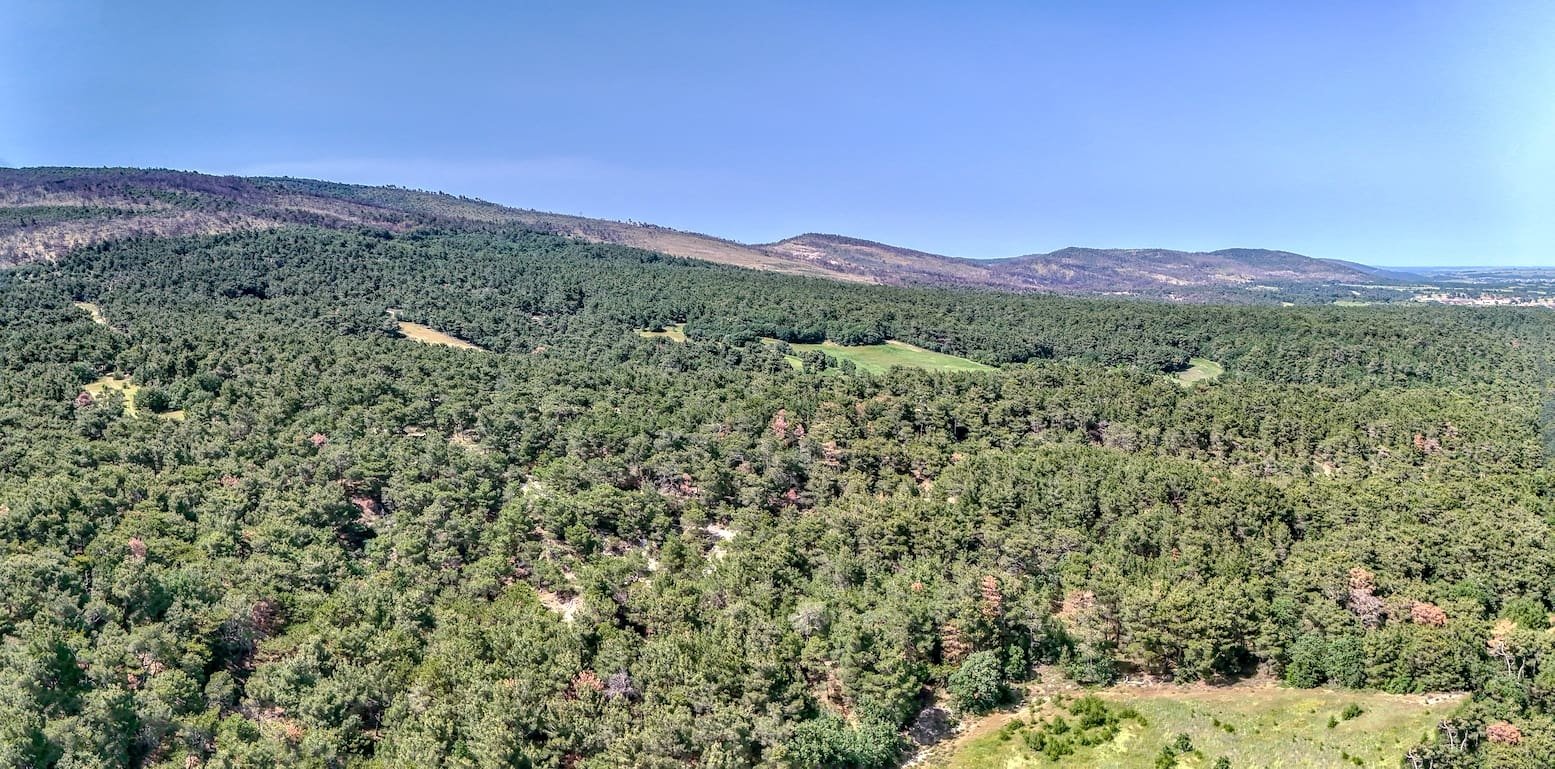
Part of the EU Natura 2000 Network, the Dadia-Lefkimi-Soufli Forest National Park is on the UNESCO World Heritage Tentative List.
Rich biological diversity fills the park’s pine and oak forests with hundreds of species of plants, butterflies, reptiles, amphibians, and mammals.
Moreover, Dadia-Lefkimi-Soufli Forest National Park has over 200 species of birds. Its nickname is “the Land of the Birds of Prey.” There’s even a Birds of Prey Observatory.
So binoculars for bird watching definitely rate high on the list of the best things to bring along.
On the park’s outer edge is a geological landmark distinct in Europe: the Lefkimi-Fylkato Fossilized Forest.
Greece’s oldest petrified forest features fossils in their original natural environment. Scientists attribute the oldest fossils to volcanic eruptions anywhere from 25 million to 40 million years ago.
Address: National Forest Park of Dadia-Lefkimia-Soufli (Εθνικό Πάρκο Δάσους Δαδιάς – Λευκίμης – Σουφλίο) | 64800 Dadia Greece
Tips to Visit Dadia-Lefkimi-Soufli National Park
Flights between Athens International Airport “Eleftherios Venizelos” (ATH) and the Region of Eastern Macedonia and Thrace serve two airports:
Firstly, to Dimokritos International Airport “Democritus” (AXD) in Alexandropoulis, the largest city in Eastern Macedonia and Thrace.
Secondly, to Kavala International Airport “Megas Alexandros” (KVA) in Kavala, the region’s second-largest city.
The best way and also the fastest way to visit Dadia-Lefkimi-Soufli Forest National Park is by car.
The driving distance between Dimokritos International Airport and Lefkimi is approximately 36 miles (59 km).
Public transportation options include KTEL and local buses with varying frequency, particularly to rural Balkan villages.
Long-distance taxis are also available for private transfers to Lefkimi and other locales.
Famous Landmarks in Greece: Epirus
The 6th Region of Greece is Epirus (Ήπειρος) in the northwest Greek mainland. The Epirus regional capital is Ioannina.
Epirus is a remarkable region of rich contrasts: An important history and a growing tech hub. Contemporary style and traditional craftsmanship.
Chic enclaves such as Preveza and Parga line the Ionian coast. Rustic villages in Metsovo, Tzoumerka, and Zagori dot the rugged mountains.
Vikos Gorge
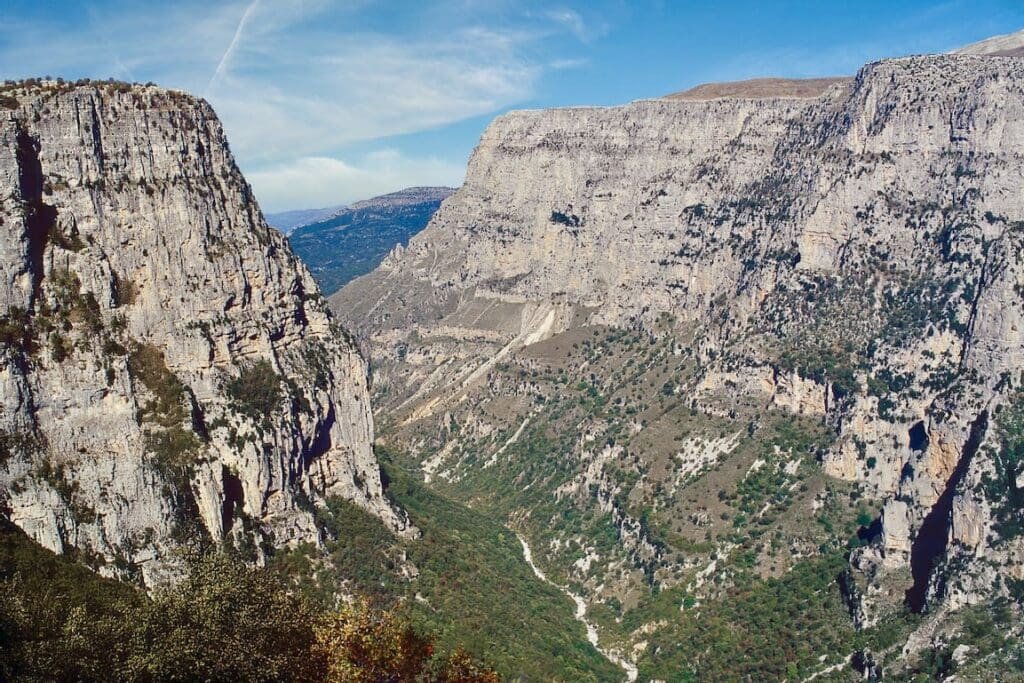
Dramatically deep Vikos Gorge is a must-see natural landmark in Zagori. In essence, Vikos Gorge is “the Grand Canyon of Greece.”
The Guinness Book of World Records 1997 affirms Vikos Gorge as one of the world’s deepest canyons for its width.
Vikos Gorge lies within the Northern Pindos National Park, uniting the National Forest of Vikos-Aoos and the National Forest of Pindos, i.e. Valia Calda UNESCO Global Geopark.
Northern Pindos National Park also contains Mount Smolikas, Greece’s second-highest mountain at 8,651 feet (2,637 m) above sea level.
Additionally, park highlights include the Voidomatis River, Voidomatis Springs, Aoos River, Aoos Gorge, and Dragon Lake.
Address: Vikos Gorge (Φαράγγι Βίκου) | 44007 Monodendri Greece
Tips to Visit Vikos Gorge
With trails ranging from easy walks to adventuresome challenges, Vikos Gorge reveals a phenomenal array of flora and fauna.
If trekking Vikos Gorge end to end is your goal, then the best time to visit Vikos Gorge is summer through early fall. Because at this time, the Voidomatis River is passable.
Northern Pindos National Park certainly remains open year-round – weather permitting, that is. However, given that snow is heavy in winter months, access and access roads can be minimal.
Five official Information Centers provide updated weather information as well as maps, hiking trails, sightseeing, observation platforms, and vista points in the National Park:
- Zagori – Asprangelon or Aspraggeli Information Center
- Zagori – Vovousa Information Center
- Metsovo – Metsovo Information Center
- Grevena – Mavranaioi Information Center
- Papigo – Papigo Information Center
Discover an exciting array of guided tours, treks, and adventures in Vikos Gorge.
Stone Villages of Zagori
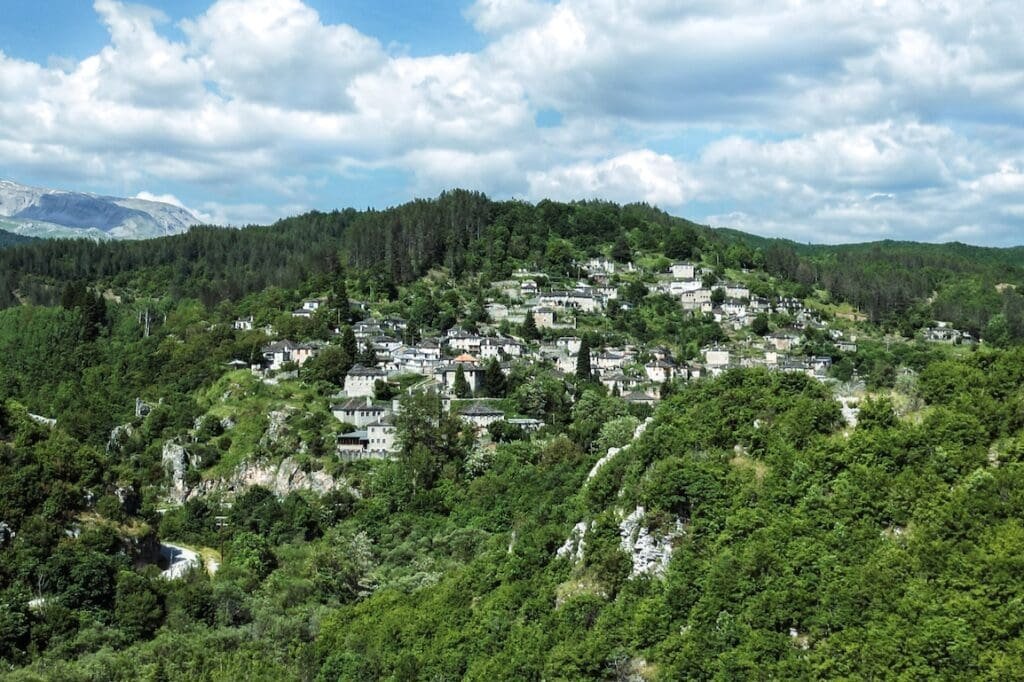
In addition to Vikos Gorge’s natural wonders, Zagori is also home to the Zagori Cultural Landscape, a UNESCO World Heritage Site inscribed in September 2023.
The Zagori Cultural Landscape honors the man-made monuments to traditional village life in the Northern Pindos Mountains.
Forty-six authentic stone villages perch on mountainsides and tuck into forests. This unique village network connects via hand-crafted stone paths, stone stairs, and arched stone bridges.
Address: Zagori – Asprangelon Information Center (Κέντρο Πληροφόρησης Ασπράγγελω) | Eparchiaki Odos Asfaka | Vrisochoriou 161 | 440007 Zagori Greece
Tips to Visit Zagori Villages
The higher you travel in Zagori, the fewer visitors you see – although the stone villages rightly achieve a certain fame with UNESCO recognition.
That’s because the Region of Epirus overall is off the beaten track, and mountainous Epirus even more so.
Ioannina and Parga are two popular gateways to visit Zagori, either by car or on a guided tour.
If you prefer exploring on your own, then we suggest stopping first at the Zagori Asprangelon Information Center.
The National Park Information Center provides historical and topographical displays, free tourist maps, and other useful materials in Greek and English.
Our experience finds the rangers and staff to be helpful and proud of the Northern Pindos National Park.
Some Zagori villages are inaccessible to cars and require hiking the stone paths, stairs, and bridges.
Other villages are accessible by local roads, such as Tsepelovo and Asprangeloi.
Tsepelovo is the largest village in Zagori – maybe 220 to 250 full-time residents – and also has the most visitor services. Asprangeloi is the village community capital.
Candidly speaking, it’s quite nice to leave not only the guiding and navigating but also the driving to experienced professionals.
In this bucolic area, free-ranging sheep, cows, and goats have the right of way over vehicles!
Famous Landmarks in Greece: Ionian Islands
The 7th Region of Greece is the Ionian Islands (Ιόνια νησιά), off the western coast of mainland Greece. The Ionian Islands’ regional capital is Corfu.
These Greek Islands in the Ionian Sea are notable for their Venetian heritage, Corfu above all.
The Ionian Islands further feature lush green landscapes and beaches with crystalline water.
Old Town of Corfu
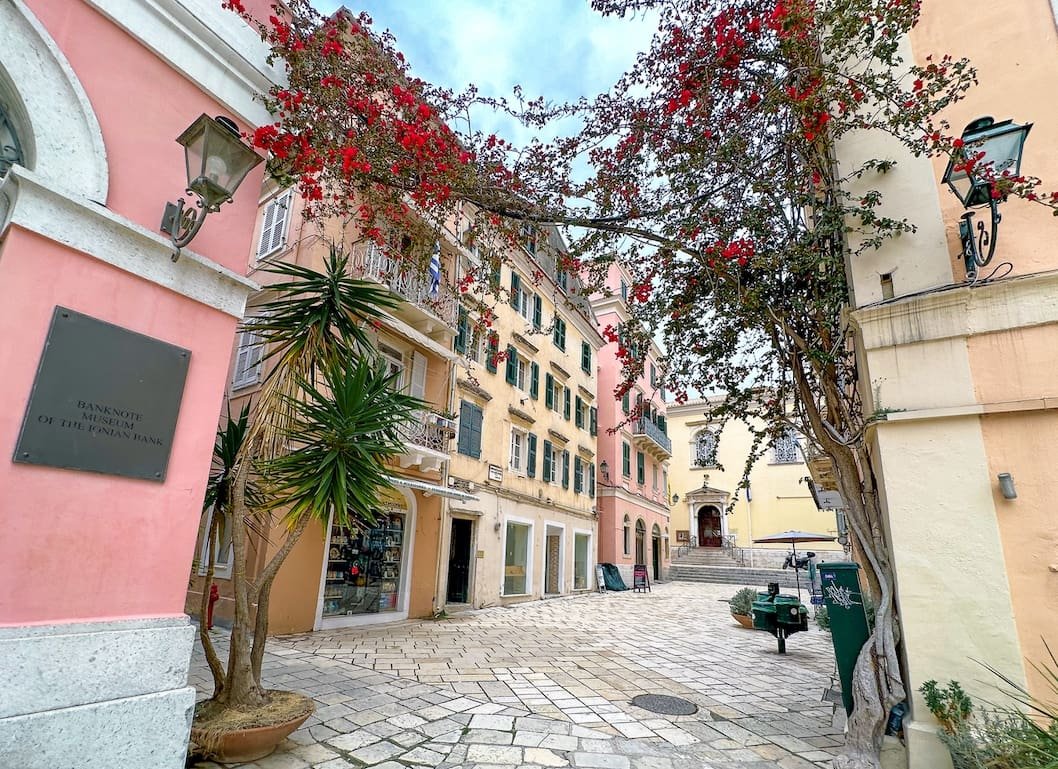
As the “Door of Venice” in the Ionian Sea until the 17th century, Corfu in the Ionian Sea simultaneously expresses Venetian legacy, Italian spirit, and Greek vitality.
Fully surrounded by monumental fortifications, Corfu Old Town is a true kastropolis (castle city) and UNESCO World Heritage Centre.
Adorned in pastel hues and accented with fresh flowers, Old Town Corfu is a welcoming and wonderful place to wander.
Cobblestone streets, intriguing alleys, and pretty piazzas beckon you to explore the historic city center.
Classic cafes welcome you to relax and revel in the European atmosphere.
Have a leisurely drink or a meal on Spianada Square. You may even catch a 21st-century cricket match on the 19th-century British cricket grounds.
Address: Old Town of Corfu (Παλαιά Πόλη Κέρκυρας) | 49100 Corfu Greece
Address: Spianada Square (Πλατεία Σπιανάδα) | 49100 Corfu Greece
Old Fortress of Corfu
Stern citadels and stout castle walls encompass Corfu, holding the island in an enduring embrace.
The 15th-century Old Fortress of Corfu, complete with the Contrafossa moat and drawbridge, successfully protected the peninsula promontory for centuries.
Nowadays, the Venetian citadel is Corfu’s most famous tourist attraction. The contra fossa moat is a canal. And the drawbridge is a permanent bridge.
Address: Old Fortress of Corfu (Παλαιό Φρούριο Κέρκυρας) | 49100 Corfu Greece
Tips to Visit Corfu
Besides living “la dolce vita” in Corfu Town, take a little break for a day trip or a day cruise.
Definitely soak up the sun and have some fun at Corfu’s alluring beaches and on the azure Ionian Sea.
Discover the romantic royal villa and imperial gardens of the Achilleion Palace, the 19th-century summer residence of Sisi, Empress Elisabeth of Austria.
Or, breathe in the fresh mountain air on Mount Pantokrator, the highest point on Corfu. Mount Pantokrator reaches 2,972 feet (906 m) above sea level.
Olive groves and villages cling to the slopes of Mount Pantokrator. In Nymfes village, an easy trail leads to the Nymphs Waterfalls. These pretty waterfalls cascade from 49 feet (15 m) high into a natural pool once the realm of mythical Nereids.
On clear days, the sea views from Mount Pantokrator sometimes reach as far as Italy and Albania.
See Corfu’s best tour and activity options.
Navagio Beach of Zakynthos
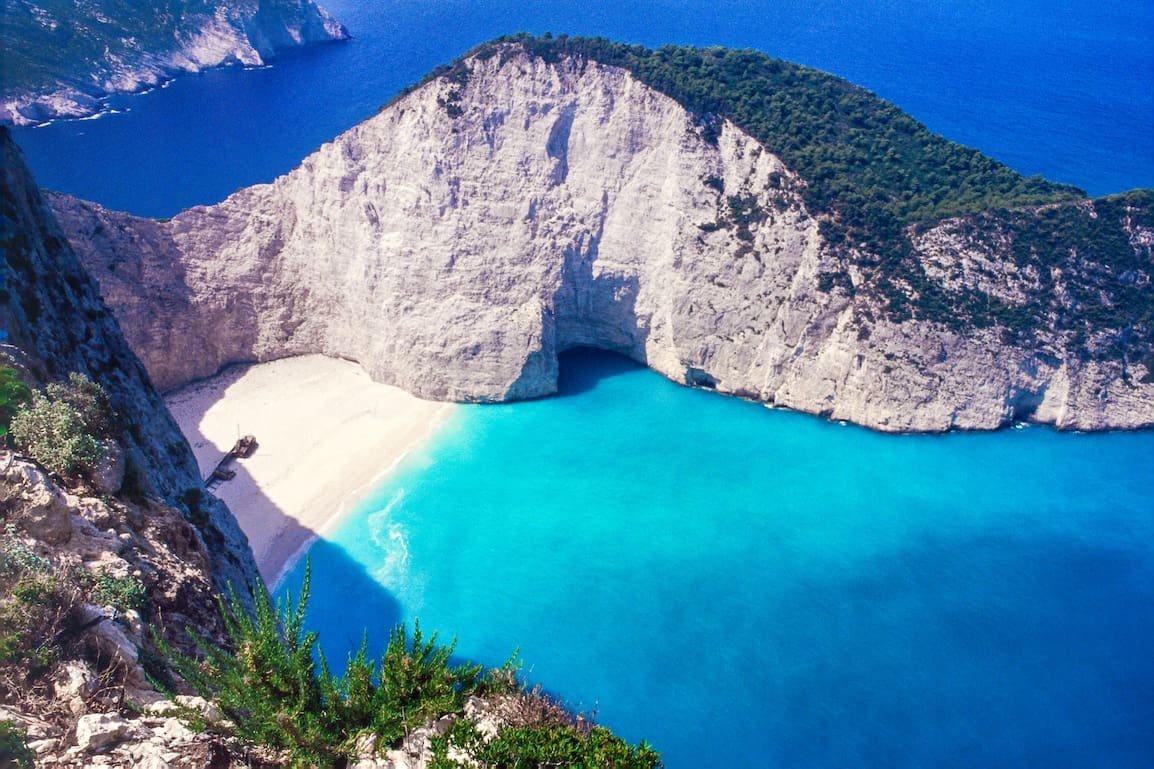
Name-dropped by Homer in both The Iliad and The Odyssey, Zakynthos blends archaeological sites and medieval elements.
But the best landmarks of Zakynthos are its natural marvels. Because of its natural beauty, Zakynthos vies with Corfu for the top spot in the Ionian Sea.
The hottest hot spot on Zakynthos is Navagio Beach. Also known as Shipwreck Beach due to the rusting ship MV Panagiotis, abandoned in 1980 on this white pebble beach.
Enclosed by high cliffs in a cove accessible only by boat, Navagio Beach is extremely popular for swimming, picnicking, and photo ops.
Indeed, some say Navagio Beach is the number one most photographed beach in all of Greece.
Address: Navagio Beach – Shipwreck Beach (Παραλία Ναυάγιο) | 29091 Elatia, Zakynthos Greece
Blue Caves of Zakynthos
The coastline around Zakynthos features striking rock formations, sea cliffs, and sea caves.
In particular, the famous Blue Caves of Zakynthos are a series of sea caves carved by azure blue waters.
Shipwreck Beach and the Blue Caves combine well on a boat excursion with a professional captain.
If tides, winds, and other conditions are right, then small boats can enter the Blue Caves. Larger tour boats must stay outside.
Additionally, there’s a public staircase by the Potamitis Windmills and Potamitis Brothers Restaurant.
The staircase zigzags along the steep cliffside for an up-close view of the crystal-clear Ionian Sea.
However, please note that due to the boat traffic, it’s not allowed to swim to the Blue Caves.
Address: Blue Caves of Zakynthos (Γαλάζιες Σπηλιές) | Venizelou 1 | 29091 Zakynthos Greece
Bay of Laganas on Zakynthos
Zakynthos provides more natural splendors besides the festive scene on Shipwreck Beach.
The beautiful Bay of Laganas, Greece’s first National Marine Park in 1999, is part of Europe’s Natura 2000 network.
Lagnaas Bay and Marathonisi islet protect the nesting grounds of endangered Caretta Caretta, loggerhead sea turtles
Marathonisi is also called “Turtle Island,” because the turtles come to its fine white sands to dig their nests.
Address: National Marine Park of Zakynthos (Εθνικό Θαλάσσιο Πάρκο Ζακύνθου) | Venizelou 1 | 29100 Zakynthos Greece
Tips to Visit Zakynthos
Due to Zakynthos International Airport “Dionysios Solomos” (ZTH) and ferry service, Zakynthos Island is easily accessible.
The most popular attractions, nevertheless, require some advance planning.
Both Shipwreck Beach (Navagio Beach) and the Blue Caves require a boat to visit. The beach has, at times, been restricted or limited due to landside concerns.
By sea, smaller excursion boats can access the Blue Caves in good weather and maritime conditions. Larger boats must remain outside the caves.
In the Bay of Laganas, the small island of Marathonisi also requires a boat to visit.
Then, only a fraction of the small beach is open to people. Because its white sands are protected breeding grounds for loggerhead sea turtles.
Furthermore, boat traffic can negatively affect the endangered Caretta Caretta, whose sightings are never guaranteed.
Alternatively, you can positively support the sea turtles by visiting the Zakynthos Sea Turtle Rescue Center and Information Center on Gerakas Beach.
In any case, to reduce the impact on turtles and other marine life, please observe these guidelines from the Mediterranean Marine Life Center.
These landmark locations are very popular in the summer months. So the best time to visit is as early as possible in the morning.
Check the best Zakynthos tour options and boat excursions.
Famous Landmarks in Greece: North Aegean
The 8th Region of Greece is the North Aegean (Βόρειο Αιγαίο), with Mytiline Island as the regional capital.
The North Aegean Islands scatter along the coast of Asia Minor.
Compared to other Greek Islands, the islands in the North Aegean Sea receive the fewest international tourists.
However, the picturesque beaches and cultural traditions of the North Aegean Region make the islands worth the wander by ferry or plane.
Mastic Villages of Chios
The birthplace of Homer, Chios Island offers Byzantine churches, a Genoese castle, lively towns, and lovely beaches.
Yet what most distinguishes Chios is its exclusive cultural landmark of mastic agriculture and Mastic Villages.
A natural resin from trees, mastic is grown, harvested, and produced by hand only on Chios.
Mastic is a Greek Protected Domaine of Origin (PDO) crop. Mastic cultivation is part of the UNESCO Intangible Cultural Heritage of Greece.
The translucent resin droplets are used in mastic gum, oil, powder, mastiha ouzo, mastiha liqueur, and much more.
Twenty-four villages comprise the landmark Mastic Villages, the Mastichochoria, in southern Chios.
Fortified gates, archways, alleys, and stone architecture amplify a romantic medieval mood in the Mastichochoria.
Pyrgi is the largest Mastic Village, and the Mastichochoria community’s capital.
Pyrgi is fondly called the “Painted Village” in reference to its distinctive decorative facades of a unique painting technique: Sfgraffito, otherwise known as Xista (Ξιστά) in Greek.
The sfgraffito painting technique layers tinted plaster to create ornamental designs in tinted plaster.
Italian and other artists employ various colors for sfgraffito. In Pyrgi, however, the traditional Xista palette is grey and white.
Address: Pyrgi (Πυργί) | 82102 Pyrgi, Chios Greece
Nea Moni of Chios

Nea Moni of Chios is a landmark 11th-century Byzantine monastery and UNESCO World Heritage Site.
The secluded environment on Mount Provateion creates a serene setting for devotion and contemplation, both sacred and secular.
The stone tower and soaring church dome of the fortified medieval monastery rise above the rugged landscape.
Imperial patronage endowed the monastic complex with magnificent mosaics, frescos, and other “indisputable masterpieces,” to quote UNESCO.
Coupled with fellow Byzantine monasteries Daphni and Hosios Loukas in mainland Greece, the Holy New Monastery of Chios represents “the second golden age of Byzantine art.”
Today, Nea Moni of Chios is a museum site and church, rather than a living monastic community of hundreds as it once was.
However, one monk still lives here at the present time of this publication.
Regardless, a respectful approach and modest attire are appropriate for all visitors when visiting Orthodox churches and monasteries.
Address: Nea Moni of Chios (Ιερά Νέα Μόνη Χίου) | 82100 Chios, Greece
Tips to Visit Chios
Chios Airport “Omiros” (JKH) serves flights from Athens and Thessaloniki regularly, and other destinations in season.
Ferries run between Piraeus, Lesbos, and Thessaloniki, as well as Çeşme, Türkiye.
A quick and easy day trip from Chios is Oinousses. Part of EU’s Natura 2000 Network, this group of nine small islands and islets are serene hidden gems.
Sculpted by Chios’ award-winning artist Mary Papaconstantinou, a bronze mermaid perches on a rock in the harbor, greeting visitors since 1986.
Famous Landmarks in Greece: Peloponnese
The 9th Region of Greece is the Peloponnese (Πελοπόννησος), with the city of Tripoli its regional capital.
The Peloponnese peninsula is a magical and mythical land – literally the stuff of legends come to life. And some of the wondrous and world-famous landmarks in Greece.
So strategic is the Peloponnese that King Otto declared Nafplio the first capital of modern Greece. Indeed, only in 1834 did King Otto and Queen Amalia move the capital to Athens.
So stunning is the Peloponnese that you’re hard-pressed to decide which landmark is the most compelling, which community is the most charming, and which beach is the most stunning.
Corinth Canal
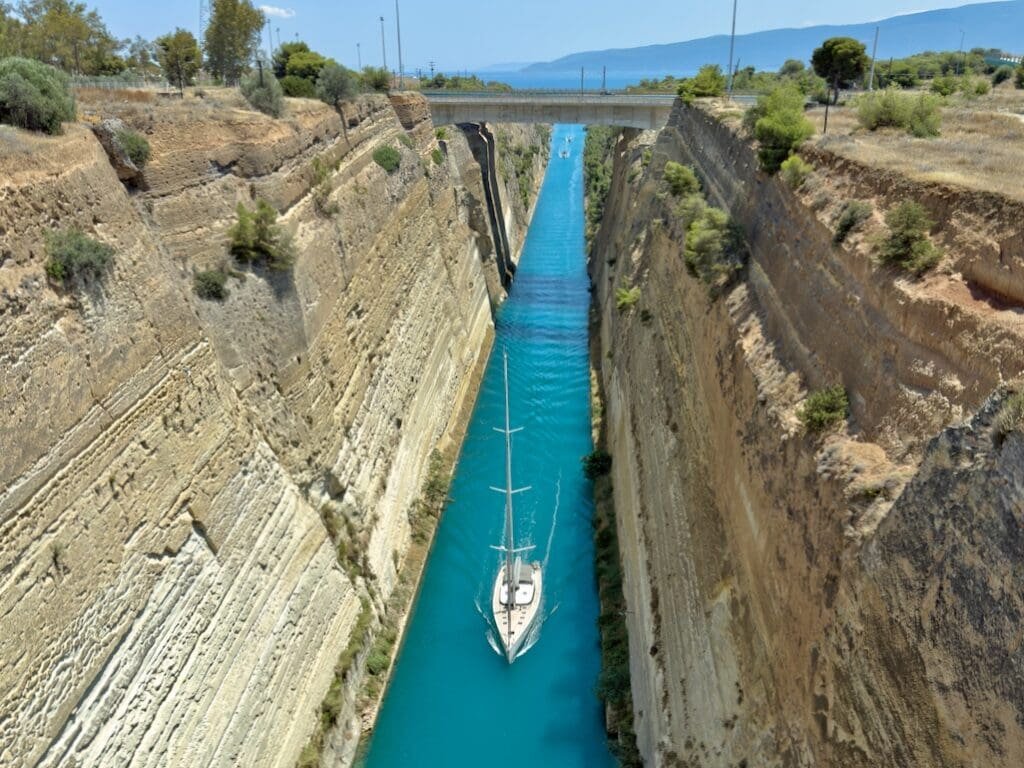
Long and narrow, the Corinth Canal unites the Region of Peloponnese and mainland Greece.
Envisioned and attempted since antiquity, the Canal of Corinth is not one of Greece’s ancient monuments.
Specifically, the canal is a late 19th-century project. Groundbreaking began in 1881, and the canal opened in 1893.
The Corinthian Canal proceeds in a single straight line for about 4 miles (6.4 km) between the Gulf of Corinth in the Ionian Sea and the Saronic Gulf in the Aegean Sea.
Towering limestone walls emphasize the canal’s narrow width, less than 81 feet (24.6 m) at sea level.
The dimensions limit the types and size of ship traffic, of course. So you won’t see the big commercial ships and tankers as on the Suez Canal, for instance, or the Panama Canal.
Address: Corinth Canal (Διώρυγα της Κορίνθου) | 20300 Loutraki Corinth Greece
Tips to Visit the Corinth Canal
Corinth Canal is a fun stop on a guided tour or day trip to the Peloponnese. It’s a popular spot, so parking, souvenirs, and cafes are located nearby to accommodate the tourist traffic.
It’s a short walk from the parking lot to the new Isthmus Bridge.
The Isthmus Bridge has a protected pedestrian walkway on either side of the road bridge. It’s a great place to watch sailboats, yachts, and tourist boats sail through the canal.
People cheer to watch adventurers bungee jump from the bridge with the official outfitter, Zulu Bungy.
Ancient Corinth

Through the ages, the city-state of Ancient Corinth exerted might, wealth, and influence far beyond its borders.
With two harbors – one on the Corinthian Gulf and another on the Saronic Gulf – and a formidable fortified acropolis, Ancient Corintha remained viable and valuable for millenia.
Ancient ruins include the Sanctuary of Demeter and Kore, Peirene Fountain, Roman Odeon, and portions of the Long Walls leading to Lechaeum, the primary port.
Two monumental landmarks emphatically convey the power of Ancient Corinthia:
Firstly, the Temple of Apollo in the Agora of Corinth dates from the mid-6th century BC. Seven of the original 42 Doric columns stand tall on this Archaic Greek temple.
Besides the mighty Temple of Apollo, the archaeological site of Ancient Corinth is vast.
Following the Ancient Greeks and Romans, the Byzantine, Crusader, Venetian, and Ottoman empires each commanded this once major metropolis.
Secondly, the Acropolis of Acrocorinth dominates the Isthmus of Corinth.
Beginning late 7th century or early 6th century BC, the Greeks and subsequently Romans, Crusaders, Venetians, and Ottomans continually strengthened and expanded Acrocorinth.
With its prime position on a high rocky hill and its freshwater spring, the citadel continues to demand respect today.
Address: Ancient Corinth (Αρχαία Κόρινθος) | Argous 105 | 20007 Corinth Greece
Address: Acrocorinth (Ακροκόρινθος) | 20007 Corinth Greece
Greek Landmarks Little Legend of Ancient Corinth
History tells us that the Apostle Paul visited Ancient Corinth in the 1st century AD. In fact, St. Paul wrote his letter to the Romans here.
Just imagine the Apostle walking the same streets, sitting under the shade trees, and resting by the Peirene Fountain. Just as you can do today, over 2,000 years later.
Tips to Visit Ancient Corinth
Yes, you can clearly see the mighty Temple of Apollo from the street running through the small contemporary town of Archaea Korinthos.
Yet it’s well worth the admission fee to enter and explore the expansive archaeological site.
Make sure to visit the quaint Archaeological Museum of Corinth on site – it’s included in your entrance ticket – and see the sculptures in the colonnade courtyard.
Sanctuary of Asklepios

Question: What do you think when you hear “Epidaurus, Greece?” Frequent answer: “Theatre.”
Well, the Ancient Theatre of Epidaurus is unquestionably the ultimate ancient amphitheater.
Indeed, Strabo gave rave reviews when writing his essential book Geography in the 1st century AD.
In the 4th century BC, sculptor and architect Polykleitos the Younger designed the theater in harmony with nature.
The Romans later expanded the theater to seat 13,000 to 14,000 guests in the audience.
Then and now, the acoustics are as close to perfect as possible.
Still, the exceptional theatre is only one of many noteworthy landmarks in this UNESCO World Heritage Site.
Dedicated to Asklepios (Asclepius), the Greek god of medicine, this Sanctuary became the role model of healing centers throughout the Classical and Early Byzantine world.
Within the sacred complex are ruins of the Temple of Asklepios, the Temple of Artemis, and a circular Tholos. The Stadium and spectator seats are additionally in use today.
Address: Sanctuary of Asclepius at Epidaurus (Ασκληπιείου Επιδαύρου) | 21052 Epidauros Greece
Tips to Visit the Sanctuary of Asklepios
It’s a popular and easy day trip from Athens to the Peloponnese Region and Epidaurus, Greece.
Impeccably restored, the Ancient Epidaurus Theatre serves as an in-demand performance space for the Athens Epidaurus Festival.
Due to this active theatrical use, the Sanctuary of Asklepios ranks among the most accessible archaeological sites for visitors of all mobilities.
When visiting the Ancient Theatre, we recommend climbing up to the top tier of marble seats if possible. Enjoy the perfect acoustics – if it’s quiet, you can actually hear a coin drop in center stage.
This perspective offers an amazing view of Polykleitos’ purposeful integration of architecture into nature. Not to mention an equally amazing Instagram spot.
Famous Landmarks in Greece: South Aegean
The 10th Region of Greece is the South Aegean (Νότιο Αιγαίο), with the regional capital on Syros Island.
The South Aegean Region encompasses the most visited and most famous Greek Island groups of all: the Cyclades and the Dodecanese.
Especially the Cyclades, with white and blue buildings wreathed in bougainvillea, are the quintessential Greek Islands of travel dreams.
Caldera of Santorini
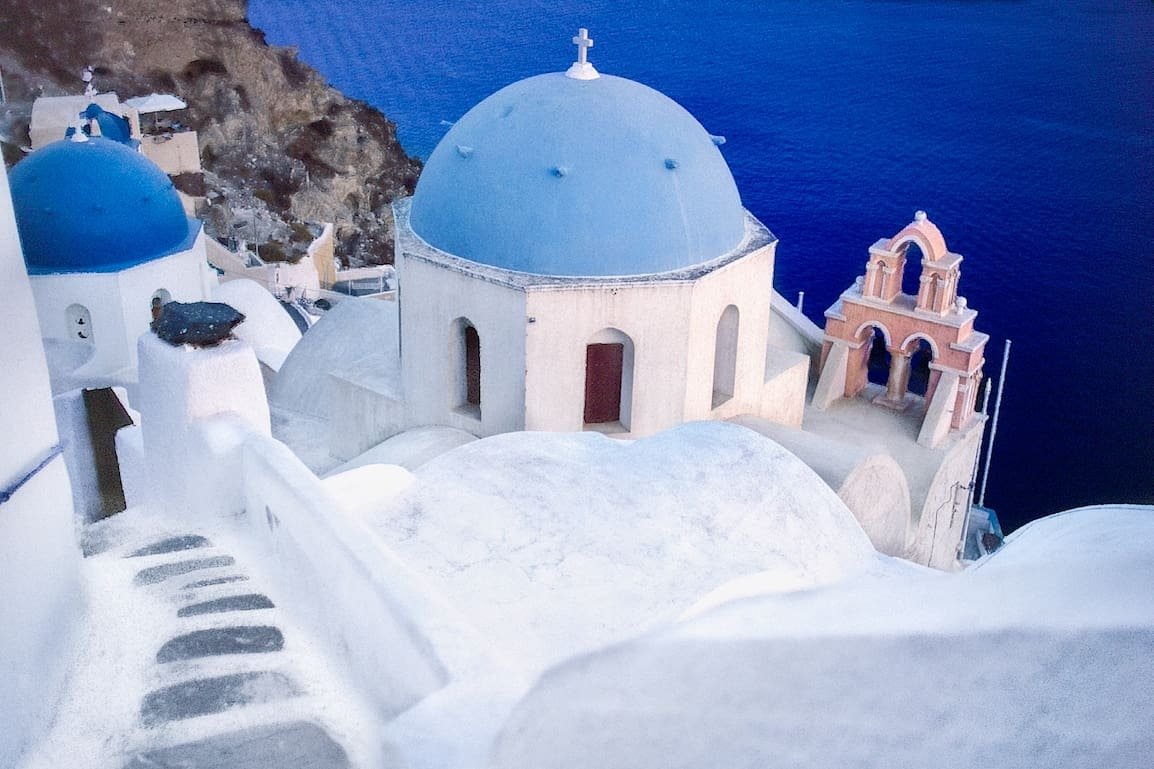
Bright white cubes and bold blue domes define the Cyclades, nowhere more astonishing than Santorini.
Santorini Island (also known as Thira, Thera, and Fira) is itself a geological landmark made by a volcanic eruption approximately 3,500 years ago. The resulting volcanic crater is the caldera.
Sailing into Santorini’s caldera is undeniably one of the world’s ultimate arrival experiences.
Against the sapphire South Aegean Sea, that first glimpse of Santorini is unforgettable. The dramatic landscape and brilliant colors astonish and amaze.
Santorini is, in sum, one of a kind – an absolutely irresistible destination for cruise ships, weddings, honeymoons, and holidays.
It’s why the tiny winding lanes of Fira and Oia are so very popular and packed in the spring, summer, and fall seasons.
Santorini’s beguiling sunsets, black sand beaches, luxurious lifestyle, and enviable Instagrammable photo ops seem limitless along the caldera.
Regrettably, it must be said that photo ops too often intrude on the roofs of private homes and churches. Please resist the urge to do that.
Or arrange a professional Santorini photoshoot, when photographers arrange permission in advance.
Address: Caldera of Santorini (Καλντέρα της Σαντορίνης) | 84700 Fira, Santorini Greece
Akrotiri of Santorini
Santorini boasts one especially important ancient landmark to visit: Minoan Akrotiri.
Destroyed in a volcanic eruption circa 17th century BC, Akrotiri of Thera links to the Bronze Age Minoan civilization so well developed on Crete.
Akrotiri was a sophisticated city with multi-story architecture, paved streets, and plumbing. Elaborate frescoes and elegant furnishings decorated the homes.
In a similar fashion to Pompeii in Italy, volcanic ash preserved the furniture outlines and also protected the ornate paintings.
Address: Akrotiri (Ακρωτήρι) | 84700 Fira, Santorini Greece
Greek Landmark Little Legend of Santorini
Various traditions deem Santorini to be a leading candidate for the lost island of Atlantis and Akrotiri as the lost city of Atlanteans.
Was submerged Atlantis either actual history, historical fiction, or mythological invention?
Well, come visit prehistoric Akrotiri and decide for yourself.
Tips to Visit Akrotiri
Given that a modern climate-controlled shelter envelops the site, which is fully accessible to all, Akrotiri is pleasant to visit any time.
Akrotiri is compelling, too, not only for the ruins but also for its legends and real stories.
Access the best tour options.
Windmills of Mykonos

The trend of Mykonos as a glitterati magnet is nothing new. Because the VIP scene on this Cycladic Island goes back to the 1960s.
First came the artists, the bohemians, and the romantic travelers. Then came the celebrities, the jetsetters, and their entourages. The paparazzi straightway followed the stars.
Amidst swanky beach clubs – the party never stops on Paradise Beach – stylish nightlife, and the best luxury hotels, Mykonos’ most famous landmark has humble origins.
Stout and sturdy Mykonos windmills once powered the island from the 16th century to the 19th century. The windmills captured the Meltemi winds blowing from the North.
Today, these white-washed Venetian-built windmills still dot the island. Many are restored, and some are renovated for vacation rentals.
Arrayed in a tidy line in Mykonos Town, the Kato Mili windmills are the much-photographed Mykonos landmarks.
Address: Windmills of Mykonos (Ανεμόμυλοι Μυκόνου) | Mpaoumi | 84600 Chora, Mykonos Greece
Little Venice of Mykonos
Little Venice is another famous Mykonos landmark. This photogenic row of cute houses with colorful wooden balconies cluster right on the Aegean’s edge.
Like the Mykonos windmills, Little Venice has hard-working origins. Formerly these houses belonged to fishermen and their families.
The families lived above their fishing boats docked below. It’s easy to picture the fishermen’s wives out on the balconies:
Waving to their husbands as they set sail before sunrise. Watching for their safe return. And later welcoming them home from the sea.
Today, tourism has transformed the old homes into seasonal restaurants, cafes, and high-end accommodations. And accordingly, sensational sunset views.
Address: Little Venice (Μικρή Βενετία) | Alekfandra | 84600 Chora, Mykonos Greece
Medieval City of Rhodes
Presiding over the Dodecanese Islands, Rhodes plays a starring role in medieval history and contemporary tourism.
For over 200 years, from 1309 to 1522, Rhodes was a Crusader stronghold and headquarters for the Order of Knights of the Hospital of Saint John of Jerusalem.
The Knights Hospitaller fashioned Rhodes, a UNESCO World Heritage Centre, in Gothic glory.
The ancient citadel city withstood earthquakes and onslaughts, shielded by a 2.4 mile (4 km) long wall, stalwart ramparts, and state-of-the-art medieval know-how.
But at last, following a long siege by Suleiman the Magnificent, the Knights surrendered in 1522 and departed Rhodes in 1523.
UNESCO notes that “the chain of history was not broken in 1523 but rather continued up to 1912.”
This unbroken chain makes medieval Rhodes one of the most fascinating historical sites, inside and outside the walled city.
Address: Medieval City of Rhodes (Μεσαιωνική Πόλη Ρόδου) | 85100 Rhodes Greece
Palace of the Grand Master of the Knights of Rhodes
Rhodes is a storybook setting – “one of the most beautiful urban ensembles of the Gothic period,” to quote UNESCO.
Just imagine the armor-clad Hospitallers parading up the Street of the Knights to the Grand Master Palace.
Astounding in style and scale, the Palace of the Grand Master of the Knights of Rhodes is among the most imposing and important landmarks of the Middle Ages.
From 7th-century Byzantine fortress to 14th-century Gothic grandeur to 20th-century Italian restoration, the Palace still continues to be relevant in 21st-century events.
Greek Landmarks Little Legend of Rhodes
“One of the 7 Wonders of the Ancient World Becomes the No. 1 Wonder of the Modern Screen” declares the trailer for a 1960s scandalous (and fabulous!) film by Italian director Sergio Leone.
Yes, the Colossus of Rhodes was one of the real Seven Wonders of the Ancient World.
Similar to the golden statue of goddess Athena on the Acropolis of Athens, this gigantic bronze statue of Helios glimmered from Rhodes far across the sea.
Ancient accounts agree that Chares of Lindos was the sculptor. But its exact location in Rhodes’ harbor, construction methods, and height description differ in ancient accounts.
Nonetheless, consensus holds the Colossus was about 105 feet (32 m) tall.
During the 3rd century BC, the Colossus inspired awe and wonder throughout the ancient world. Until it fell over in an earthquake.
Tips to Visit Rhodes
With Rhodes a top tourist destination, even in shoulder season and especially in summer, timing matters to visit the Grand Masters Palace, its top attraction.
The best time to go is either at opening hour or in late afternoon. Correspondingly, a stroll along the Street of the Knights satisfies the senses. Also, it’s a fabulous photo op when empty.
Then, if schedule permits, take a short walk or long stroll along the castle walls. Bring water, a hat, sunglasses, and sunscreen.
Lastly, consider a professional guided tour to understand Rhodes’ complex history and equally complex architecture.
Famous Landmarks in Greece: Thessaly
The 11th Region of Greece is Thessaly (Θεσσαλία), with Larissa as the regional capital.
Once upon an epic time, Hesiod’s Olympian gods and Homer’s hero Odysseus adventured in Thessaly aeons ago.
Today, faithful pilgrims, outdoor enthusiasts, and “set-jetting” show fans alike travel to Thessaly for a different kind of epic time.
Meteora
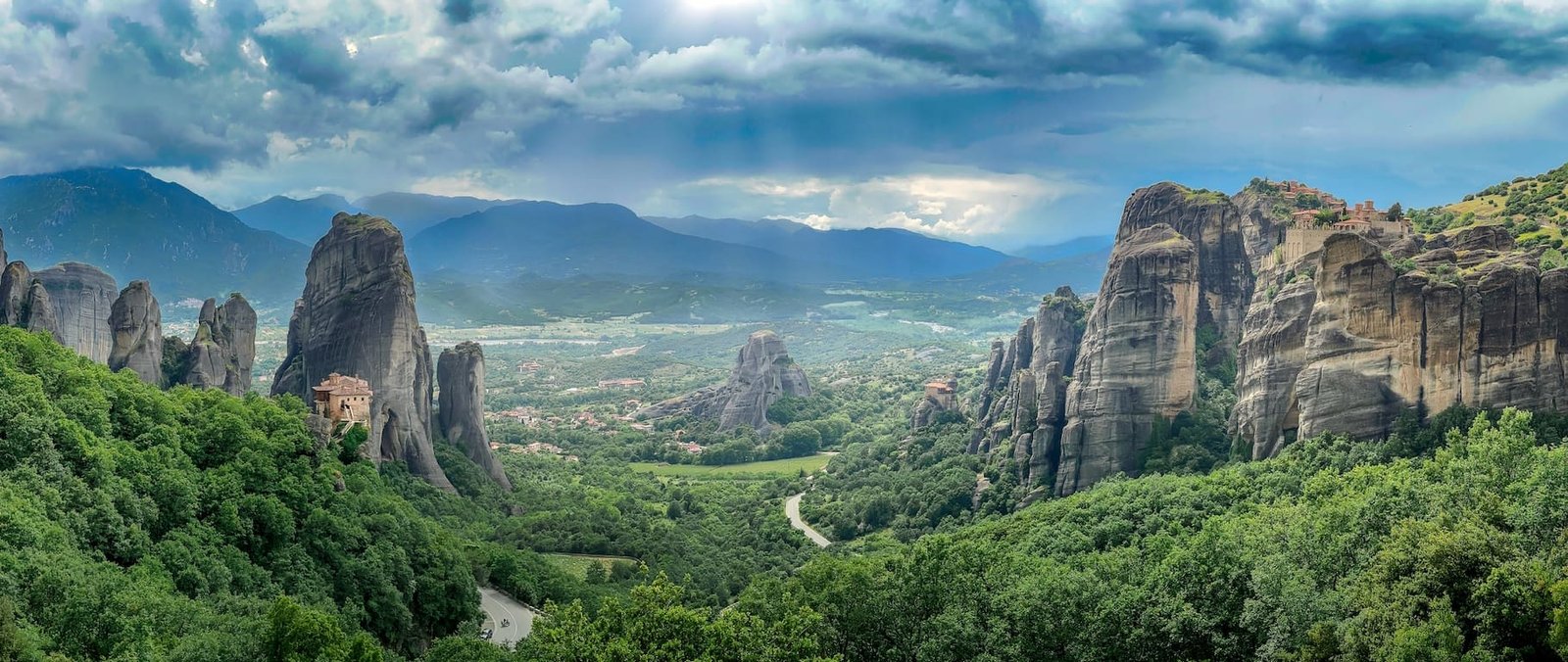
Above Thessaly’s golden fields and green mountains, solitary sandstone pillars soar in sheer splendor against the sky.
Atop these individual towering peaks, monumental faith, dedication, and endurance built the monasteries of Meteora decade upon decade, century following century.
In the 11th century AD, hermits seeking solitude first scaled these steep rock formations.
Then, slowly hauling up stone after stone with painstaking labor, monks built by hand a total of 24 monasteries atop 24 separate peaks.
Six of the 24 remain as living monasteries, still inhabited and active. All six monasteries are a UNESCO World Heritage Site.
These six Meteora monasteries differ in accessibility for present-day visitors:
- With 300 steps each, the Holy Monasteries of Great Meteoron and the Holy Trinity are the longest climb up and down.
- The Holy Monasteries of Rousanou, Saint Nicolaos Anapfasas, and Varlaam each have approximately 140 steps.
- The Holy Monastery of Saint Stefanos has the easiest accessibility, thanks to a small bridge with only a few steps.
Oh yes, and Saint Stefanos is a thriving female monastery, a convent.
In 1961, a small group of Orthodox nuns petitioned for permission to reside in and restore the derelict 15th-century monastery.
Today, Saint Stefanos’ religious community continues to grow, attracting women of all ages to godly service. We’ve had the privilege to meet some of the Agios Stefanos sisters, including one of the original 1961 pioneers.
Address: Meteora (Μετέωρα) | 42200 Kalambaka Greece
Greek Landmarks Little Legend of Meteora
In 1981, the James Bond movie For Your Eyes Only introduced Meteora to the wider world.
Star Roger Moore, cast, and crew filmed pivotal scenes around the landmark monasteries – specifically at the Holy Monastery of the Holy Trinity (Agia Triada).
However, on-site filming at Agia Triada disrupted the monastic rhythms and the sacred setting.
Consequently, film and TV productions on location in Meteora were strictly limited.
Subsequently, Meteora has inspired scenes in The Young Indiana Jones Chronicles, Pokemon: Arceus and the Jewel of Life, and even video games.
And perhaps most famously, the Eyrie in HBO’s blockbuster show Game of Thrones.
As a result, Meteora is among the Greek destinations for “set-jetting,” the travel and tourism trend to visit locations seen on TV and movie screens.
Tips to Visit Meterora
The town of Kalabaka, also spelled Kalambaka, is the gateway to visit Meteora.
Whether you arrive in Kalabaka by train, bus, or car – which you can certainly do on a day trip from Athens or Thessaloniki – a guided tour is the best way to visit Meteora.
The access road up and down to the monasteries is crowded with buses, more buses, bicyclists, and occasionally pedestrians.
So leave the driving to the expert, relax in plush leather seats, and listen to the professional local guide.
Since narration isn’t allowed at the monasteries, your newfound knowledge from the tour guide can heighten your appreciation.
We highly recommend the small group tour experience with the award-winning local agency Visit Meteora.
Explore the best Meteora tour options.
Tips to Visit Meteora Monasteries and Churches

Whether visiting on your own or taking a guided tour, Meteora monastery admissions are additional.
Although it’s uncommon for Orthodox monasteries and churches to charge admission, the small fees at Meteora help defray the significant upkeep of these ancient sites.
So, bring cash for the nominal admission fees; 3 Euros per monastery at this time of publication.
Additionally, the cash comes in handy if you wish to light a candle, make an extra donation in support, or need to cover bare shoulders, arms, or legs.
Modest attire is necessary for all visitors; bare shoulders, arms, and legs are not allowed. A Meteora monastery may or may not have inexpensive wraps to purchase at the entrance.
During the warm months, we suggest a lightweight shawl, loose pants, or long skirt that slips on and off quickly but takes up little space in a bag or tote.
Famous Landmarks in Greece: Western Greece
The 12th Region of Greece is Western Greece (Δυτική Ελλάδα). Patras, the Western Region capital, is the third-largest city in Greece after Athens and Thessaloniki.
Western Region comprises two sections, one section on the mainland and another section on the Peloponnesian peninsula.
Due to state-of-the-art engineering, the Rio Antirio Bridge spans the Gulf of Corinth and thus joins the two halves of Western Greece.
Besides this modern engineering masterpiece, Western Greece boasts enchanting Venetian gems like Nafpaktos. And an extraordinary Ancient Greek treasure like nowhere else.
Ancient Olympia

Broadcast to billions around the world, the Modern Olympic Games trace their origins to Ancient Olympia in the Region of Western Greece.
The Modern Olympics are eternally rooted in this UNESCO World Heritage Site unique in the world.
Every four years starting circa 776 BC, Ancient Olympia hosted the Ancient Olympic Games.
At the Olympiads, the Pan-Hellenic world gathered at the confluence of two rivers to celebrate athletic competition and peaceful camaraderie.
Thousands of years later, Ancient Olympia hosts the first ritual of all Modern Olympic Games: Lighting the Olympic flame before each Summer and Winter Olympics.
The ancient archaeological site of Olympia also served as the Sanctuary of Zeus, king of the mythical gods.
As such, the site in ancient times held hundreds of buildings, few more famous than the Temple of Zeus and the Ancient Olympic Stadium.
As such, the site in ancient times held hundreds of buildings, few more famous than the Temple of Zeus and the Ancient Olympic Stadium.
Address: Ancient Olympia (Αρχαιολογικός Χώρος Ολυμπίας) | 270675 Archaia Olympia Greece
Temple of Zeus at Olympia
Befitting the King of Greek gods, the Doric Temple of Zeus contained one of the Seven Wonders of the Ancient World: the golden Zeus.
In the 5th century BC, eminent Phidias of Parthenon fame sculpted a superlative statue of Zeus enthroned in gold and ivory.
Excavations in the 20th century AD uncovered Phidias’ workshop on-site, complete with tools, molds, and material remnants.
Unfortunately, like the bronze goddess Athena on the Acropolis of Athens and the Colossus of Rhodes, this exquisite sculpture from the Temple of Zeus in Ancient Olympia disappeared long ago.
Stadium at Ancient Olympia
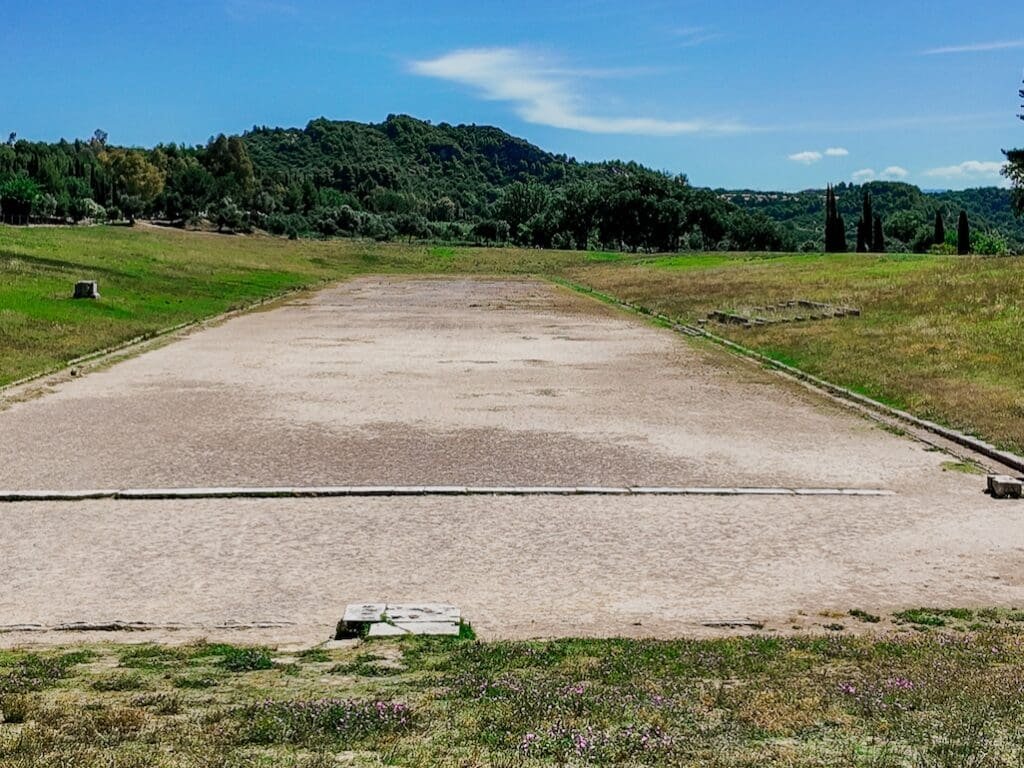
One of the best places and most beloved attractions in Olympian Land, the Stadium invites you to follow in the footsteps of ancient athletes:
Firstly, walk through the vaulted tunnel into the stadium. Take your position on the marble starting blocks.
Then, hear the starting whistle silently blow. Then run like the wind down the track.
Finally, cross the finish line in triumph. Raise your arms in a “V” for victory.
Lastly, visualize the enthusiastic crowd leaping to their feet. Their applause is a thunderous barrage.
Now feel the eternal thrill to place the victor’s wreath of olive leaves on your brow.
Famous Landmarks in Greece: Western Macedonia
The 13th Region of Greece is Western Macedonia (Δυτική Μακεδονία), with the regional capital at Kozani.
Western Macedonia gains renown for its tremendous history and heritage, such as Byzantine Kastoria.
Yet Western Macedonia finds the greatest fame for its tremendous natural beauty.
Surprisingly, Western Macedonia is the only land-locked region in Greece. Not surprisingly, its mountains and lakes are indeed legendary.
Lake Orestiada, Kastoria
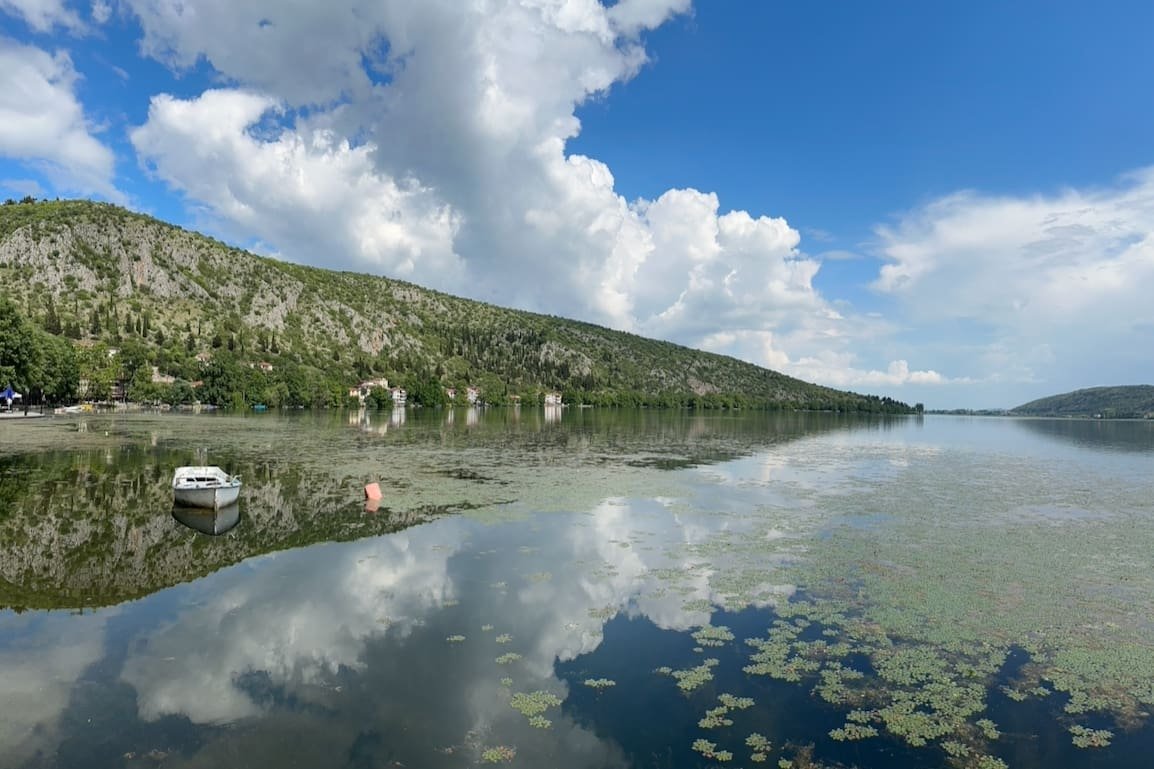
In the Region of Western Macedonia, Lake Orestiada (Orestias) is a Greek National Monument of Natural Beauty.
Rugged mountains frame the tranquil lake, approximately 11 square miles (28 km2). With the historic town Kastoria rising on the promontory, the alpine ambiance enchants.
A long waterfront promenade connects bustling New Town Kastoria with Byzantine Kastoria.
The lakefront is the best area for locals and visitors alike to exercise, see, and be seen at one or another of the numerous waterfront cafes.
Within the EU Natura 2000 network, the lakeshore makes a perfect location for year-round bird watching.
Over 50 species of birds, including threatened and rare species, flock to Lake Orestiades.
Kastoria’s famous mute swans, pelicans, mallard geese, and other water birds remain year-round. More species migrate here to nest and breed during the winter months.
Another lakeside natural attraction is Spileo Drakou, Cave of the Dragon. The Cave of the Dragon is located on the peninsula, about 1.5 miles (2.5 km) beyond Kastoria Old Town.
Significantly large, the Dragon’s Cave has underground freshwater lakes, the only ones in Greece. As well as bridges, halls, tunnels, and of course, countless stalactites and stalagmites.
Address: Lake Orestiada (Λίμνη Καστοριάς Ορεστιάδα) | 52100 Kastoria Greece
Address: Dragon’s Cave (Σπήλαιο του Δράκου) | Sougaridi | 52100 Kastoria Greece
Tips to Visit Lake Orestiada, Kastoria
The driving distance between Athens International Airport “Eleftherios Venezilos” (ATH) and Kastoria is about 370 miles (595 km).
Kastoria National Airport “Aristotelis” (KSO) is a small local airport, busiest in peak season.
To clarify, the peak season here in Kastoria is the winter months. When snow falls on the mountains, Mount Visti ski resort opens, and Lake Orestiades occasionally freezes.
During all four seasons, Lake Orestiada and Kastoria are magical and memorable to visit.
Famous Landmarks in Greece: Mount Athos
The 14th Region of Greece is Mount Athos, the Holy Mountain (Άγιο Όρος), Agio Oros.
The monastic town of Karyes serves as the Athonite regional capital.
Mount Athos forms an ancient, sacred, and somewhat autonomous region on the easternmost of three Chalkidiki peninsulas in Central Macedonia.
Holy Mountain of Mount Athos
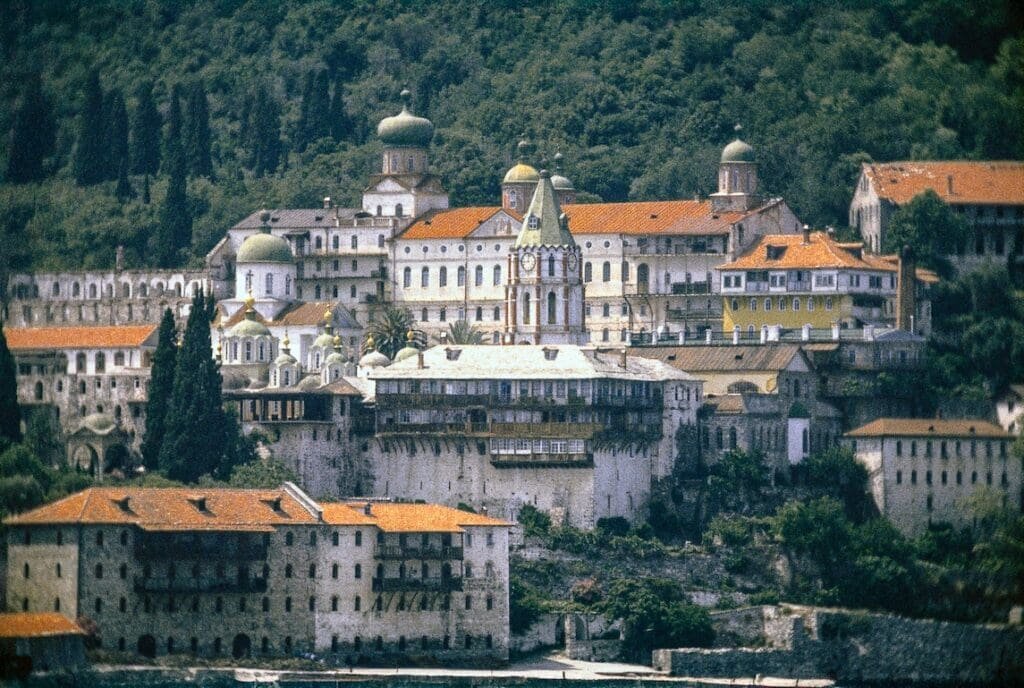
The Holy Mountain of Mount Athos is a UNESCO World Heritage Site unique in the world.
Since AD 972, when Byzantine Emperor John I Tzimiskes signed its first constitution, Mount Athos has been the spiritual heart of all Orthodox monastic communities.
Over 1,050 years later, the Holy Mountain chiefly runs on Byzantium time, flies the Byzantine flag, and follows the ancient Julian calendar.
Today, more than 2,000 monks from Greece, Serbia, Romania, Bulgaria, and other Orthodox countries live, work, and worship in approximately 20 historic monasteries.
Faith permeates every aspect of life here. From religious pursuits; for example, liturgical services and icon painting. To practical vocations; for instance, farms, forestry, kitchens, libraries, etc.
Even outdoor activities like hiking the Holy Mountain connect faith to fresh air and nature.
Mount Athos is like nowhere else. So much so that Guinness World Records 1977 records Mount Athos as the world’s most male-dominated society.
Because a law from AD 1066 specifies no females of any age, or boys under 18 without fathers or guardians, may set foot on Mount Athos.
Greek Landmarks Little Legend of Mount Athos
Tradition tells us that in the 1st century AD, Saint John the Evangelist and the Holy Mother sheltered on Mount Athos during a storm.
From that time on, both the Athonite traditions and the 1066 law state the Virgin Mary would be the only female to set foot on Holy Mountain.
Tips to Visit Mount Athos for Male Pilgrims
As noted previously, only males may visit Mount Athos. All potential male visitors are potential pilgrims, whether or not they’re Orthodox Christians.
In order to set foot on Mount Athos, all pilgrims must seek a date-specific permit or visa before the pilgrimage.
Age and other regulations apply to receive this written permission, the diamonitirion.
Agioritiki Estia, the official Mount Athos Center, explains the application protocol and process for potential pilgrims.
To make reservations up to six months prior, contact the Pilgrims Bureau Office in Thessaloniki via phone, fax, or email at:
The Mount Athos Pilgrims’ Bureau
Egnatia Street 109
54622 Thessaloniki, Greece
Phone: +(30) 2310-252578
Fax: +(30) 2310-222424
E-mail: athosreservation(at)gmail(dot)com
Tips to Visit Mount Athos for Everyone
For women, couples, families, and everyone else, the best way – and, in truth, the only way – to see Mount Athos is on a boat tour.
Small cruise ships and private tour boats with local guides can sail as close as 1,640 feet (500 m) to the Holy Mountain’s shoreline.
Certain cruises and private boats take a sacred approach, a pilgrimage by sea if you will.
Other group tours are secular in nature. Some excursions include a visit to Ammouliani, the inhabited island of Chalkidiki, or other scenic spots.
The best time to plan an Athonite pilgrimage, by land for men or by sea for others, is either mid-April to mid-June or mid-September through October. The weather is comfortable, the crowds are manageable, and the Aegean Sea is calm.
High season, from mid-June until mid-September, can be very hot. The Aegean Sea is at its calmest, of course, but also crowds are greatest.
Winter is cold, wet, and sometimes snowy, although uncrowded. We’ve also heard that some monasteries now have heating systems, adding a touch of comfort to winter pilgrimages.
Discover the different boat excursions to Mount Athos.
Famous Landmarks in Greece: In Conclusion
Greece is rightly a popular destination for beautiful beaches, sparkling seas, and some of the world’s most famous landmarks.
Greek mythology, rich history, and man-made monuments aside, other important landmarks of natural beauty convey nature’s glory in national parks, forests, mountains, lakes, and seas.
Whether you travel across mainland Greece or to the Greek Islands, there’s something special to discover everywhere in the 14 Regions of Greece.
So come visit Greece. Come discover these legendary landmarks and legendary stories for yourself.
•••
Interactive Map of Famous Landmarks in Greece
Landmarks in Greece: Ancient Sources
Hesiod, Theogony and Works and Days. Translated by M. L. West, Oxford World’s Classics, Oxford University Press, 2005.
Homer, The Iliad. Translated by Emily Wilson, W.W. Norton and Company, 2023.
Homer, The Odyssey. Translated by Emily Wilson, W.W. Norton and Company, 2017.
Ovid, Metamorphoses. Translated by David Raeburn, Penguin Classics, Penguin Publishing Group, 2004.
Pausanias, Guide to Greece Volume 1: Central Greece. Translated by Peter Levi, Penguin Classics, Penguin Publishing Group, 1984.
Pausanias, Guide to Greece Volume 2: Southern Greece. Translated by Peter Levi, Penguin Classics, Penguin Publishing Group, 1984.
Strabo, Strabo’s Geography: A Translation for the Modern World. Translated by Sarah Pothecary, Princeton University Press, 2024.
Landmarks in Greece: Modern Resources
Hawes, Greta, editor. Myths on the Map: The Storied Landscapes of Ancient Greece. Oxford University Press, 2017.
McKinney, John, Hiking the Holy Mountain: Tales of Monks and Miracles on the Trails of Mount Athos, Greece. Olympus Press, 2024.
Michelin, Streetwise Athens and the Greek Islands Map: Laminated City Center Street Map of Athens, Greece. Michelin Streetwise Maps, 2023.
Rosetta Stone, Greek Language Instruction Software: Learn Unlimited Languages with Lifetime Access. Rosetta Stone, 2019.
Check Out More Recommendations
GET: Now that you’re ready to visit famous landmarks in Greece, get your exclusive free guide to tell your travel stories easily.
•••
Famous Landmarks in Greece: FAQs
How many famous landmarks in Greece are there?
Famous Greek landmarks encompass a vast range of history, culture, and nature. So let’s use the UNESCO landmarks list as our benchmark: As of July 2025, Greece presently has 20 landmarks registered as UNESCO World Heritage Sites and 12 landmarks on the UNESCO Tentative Lists. Greece also has 3 UNESCO World Biosphere Reserves.
What is the most famous landmark in Greece?
The most famous Greek landmark is the ancient Acropolis of Athens, Greece. The Parthenon, the incomparable temple of the goddess Athena, is the ultimate monument on the Athenian Acropolis.
What is the most visited Greek landmark?
The most visited landmark in Greece is the Acropolis of Athens, the crowning glory of the Greek capital since the 5th century BC.
What is the most popular Greek Island?
The most popular Greek Island group is the Cycladic Islands in the South Aegean Sea. The two most visited Greek Islands are, firstly, Santorini and, secondly, Mykonos in the Cyclades.
What is the most famous landmark in the Greek Islands?
The most famous landmark on Santorini, the most-visited Greek Island, is its caldera, the volcanic crater. This geographical landmark made the island. On Mykonos, the 2nd most-visited Greek Island, the most famous landmark is its 16th-century to 19th-century windmills.

All opinions expressed are Spotlight Sojourns’ own.
All content and images are original, created with care by yours truly, Marilee Kostadimas and Paul Kostadimas. We’re the Hidden Gemologists® of Spotlight Sojourns: Award-winning travel experts and slow travel storytellers. Because slow travel is meaningful travel, part of a meaningful life. And stories enrich the meaning.


